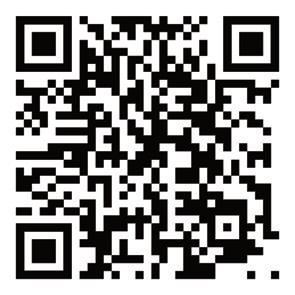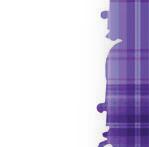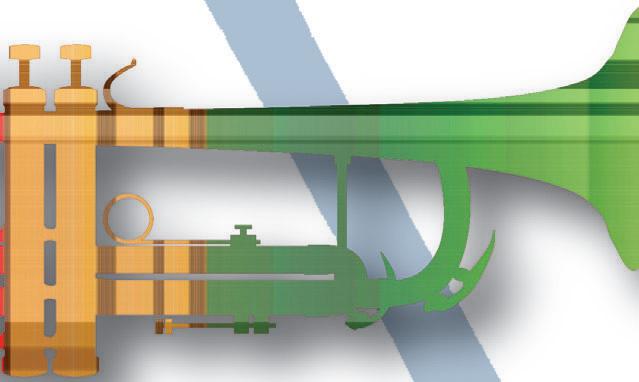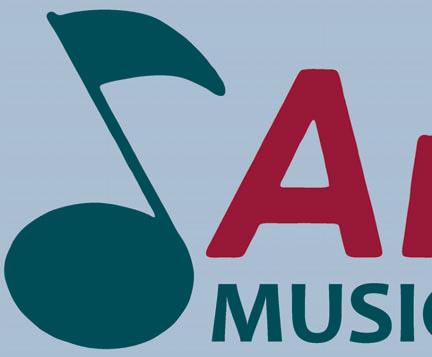ala breve







The University of North Alabama Department of Music offers scholarships to qualified music majors and minors in all instrumental, vocal, and piano programs through auditions.



Participants in University Ensembles may be eligible for a Performance Award, regardless of their academic major.
Audition Dates:
November 11, 2022
January 27, 2023
February 25, 2023
March 18, 2023 Contact us una.edu/music ● 256.765.4375 music@una.edu ● @unamusic1
Degrees
Bachelor of Music in Performance
• Instrumental
• Piano

• Vocal
Bachelor of Arts or Science in Music
• Instrumental
• Vocal / Choral
Bachelor of Science in Education
• Choral Music, P-12
• Instrumental Music, P-12
Minor
• Music Certificates
• Musical Theatre
• Percussion Specialist
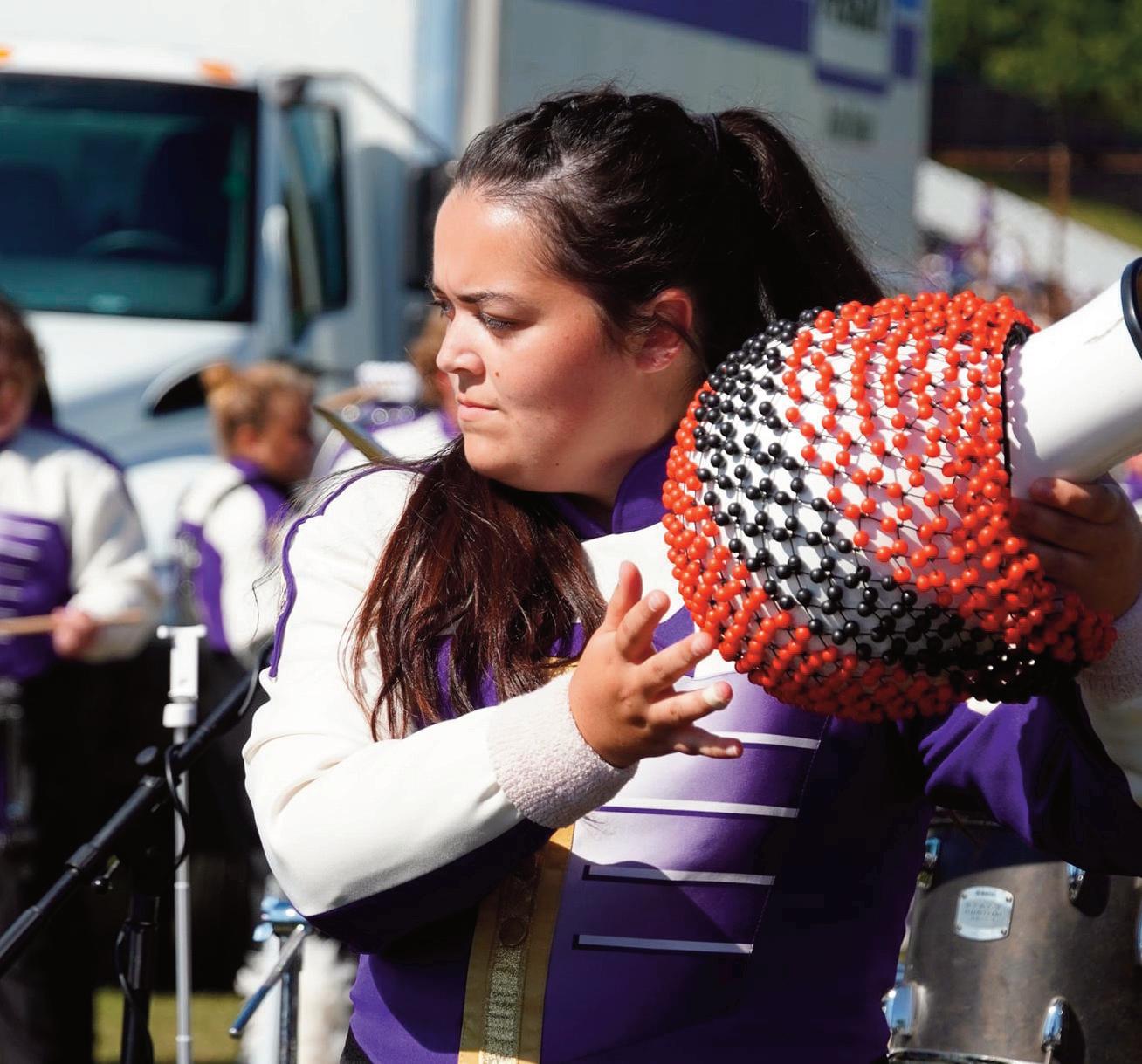




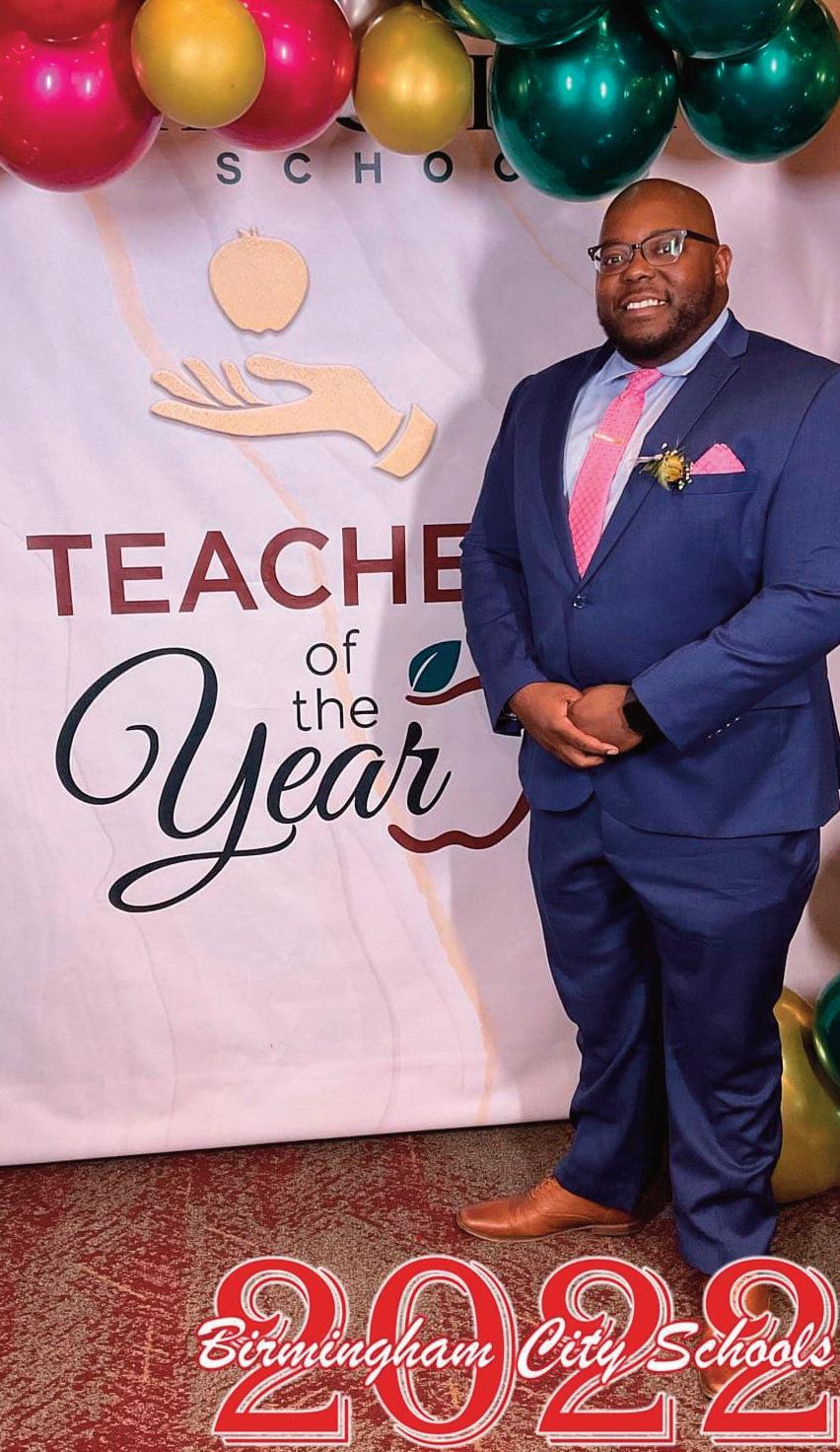
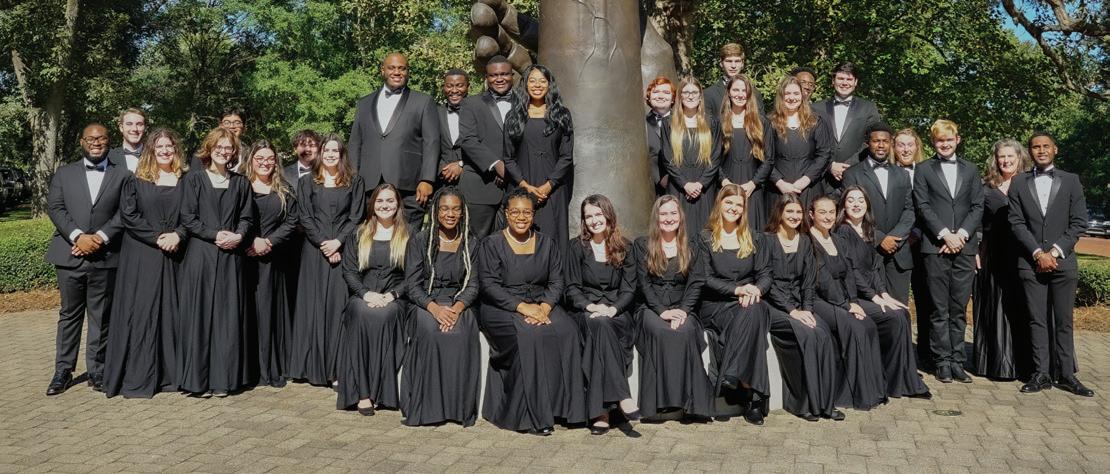



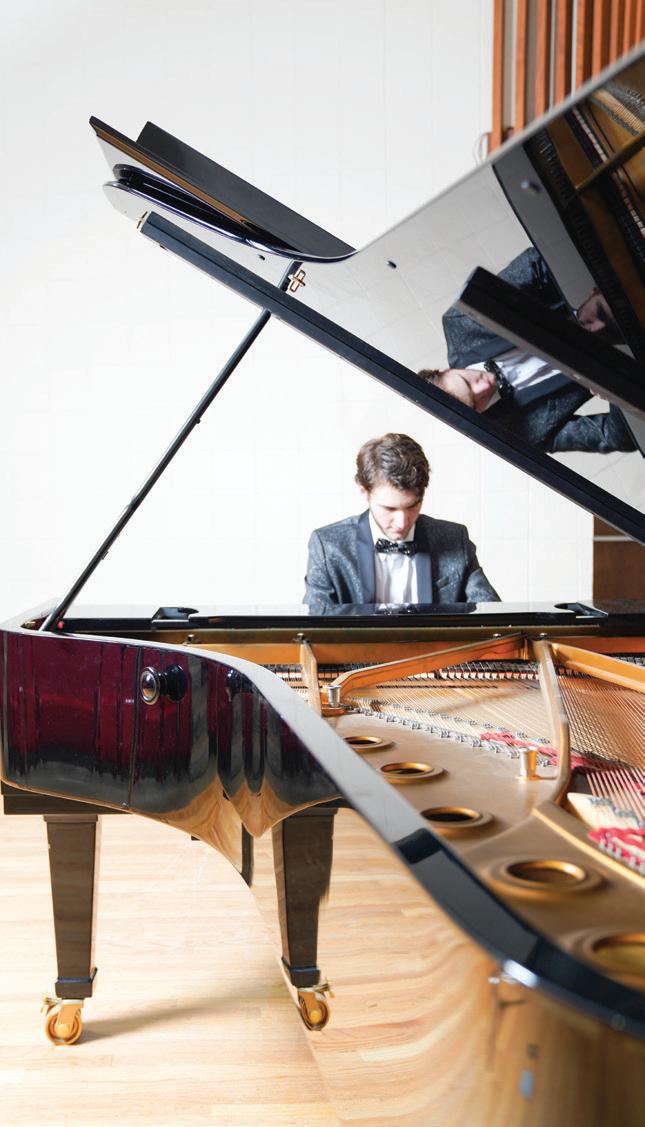
For Middle & High School Students
Sept. 30, 2022 Festival of Voices


Oct. 15, 2022 All-State Choir Workshop
Nov. 5, 2022 Single Reed Symposium
Feb. 17-18, 2023 Middle School Honor Band



March 3-5, 2023 High School Honor Band
March 21, 2023 Choral Festival Day
For Scholarships
Jan. 28, 2023
Feb. 25, 2023
March 4, 2023
Honor Band participants only
March 18, 2023

I’ve been trying to find adequate words to express my thoughts and feelings since returning from Birmingham. I sit in front of my computer trying to come up with words and my mind wanders back to all of us being together. I try to think how I can sum up three incredible days of learning, laughter, comradery, and music. What could I possibly say that would encapsulate all that our annual AMEA Professional Development Conference provided to us?
In my humble opinion, the sincerest thing I can offer to you is my gratitude. I’m grateful for your energy. I’m grateful for intellectually stimulating sessions and conversations. I’m grateful for soulstirring student performances. I’m grateful for our exhibitors. I’m grateful for Dr. Deb Confredo listening to us and encouraging us to work for music education for all. I’m grateful to the Dill Pickers for providing music, an opportunity to tap our toes, and put a smile on our faces. I’m grateful to our AMEA staff – Dr. Rusty Logan, Garry
Taylor, Pat Stegall, and Dr. Carl Hancock for making sure everything ran so smoothly. I’m grateful to the AMEA governing board for their dedication and service to all of you. Most of all, I’m grateful to you for investing in your personal professional development to be the absolute best teacher for your students. Thank you for your commitment to the children of Alabama. Our time together in Birmingham was simply wonderful.
As I mentioned at the conference, we broke our previous attendance records. In all, we had 1,091 people register for the conference. ABA had 529 attendees, AOA had 22 attendees, AVA had 149 attendees, Elementary/General had 170 attendees, cNAfME had 126 attendees, Higher Education had 49 attendees, and 46 attendees didn’t indicate a division affiliation. While we revel in our recordbreaking attendance, we know there are areas we can improve. Based upon the Governing Board’s Saturday meeting and the conference evaluations many of you completed, we have identified several
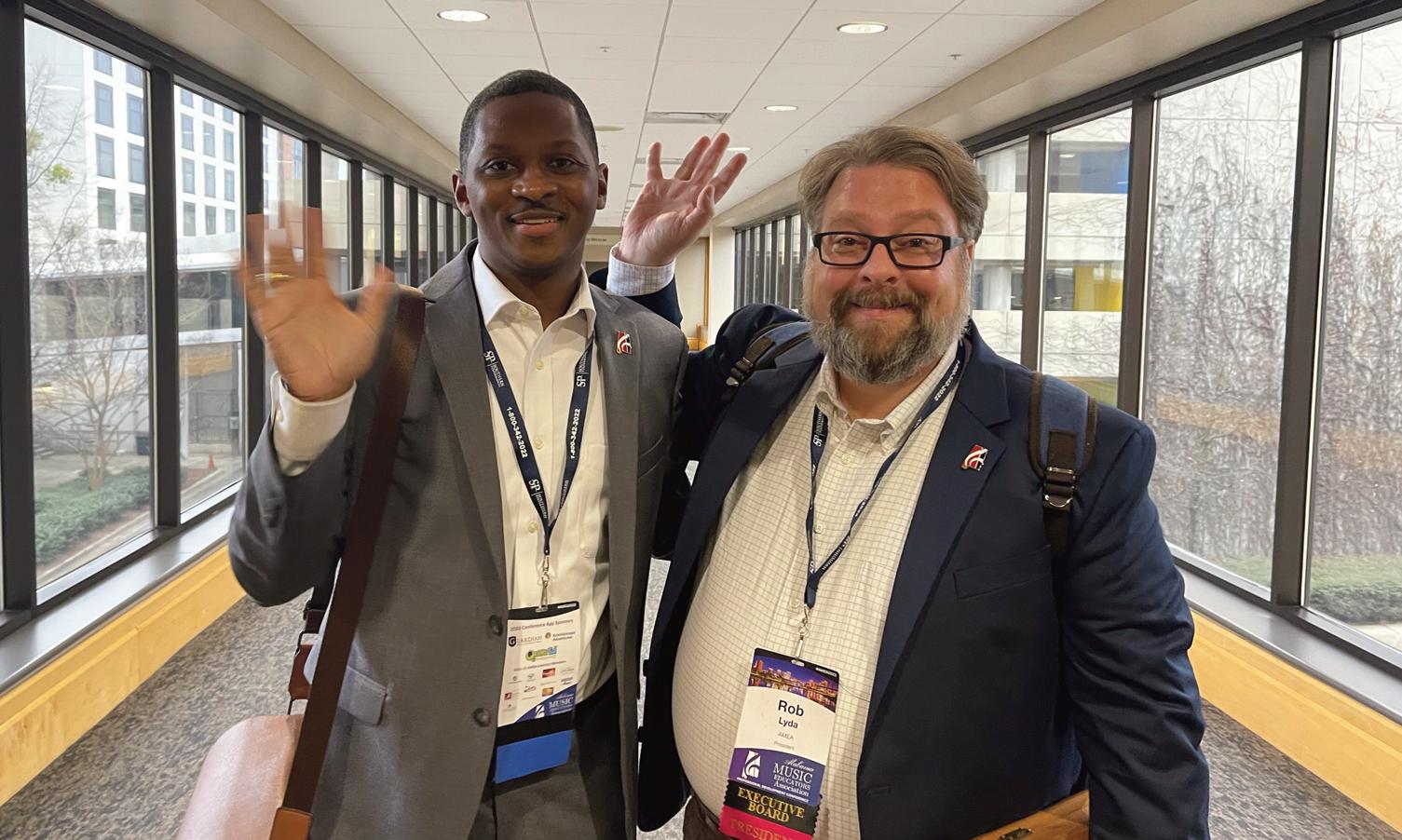
areas we would like to further evaluate and improve for the Huntsville conference.
I would like to offer two suggestions to improve our future conferences. We are fortunate that each division can devote resources to bringing in well-known clinicians as headliners. Out-of-state clinicians are fabulous and give the conference a little pizazz, but nothing beats our homegrown Alabama music educators. There are many talented folks from Alabama that should be presenting at our conference. Some of you do incredible things that should be highlighted. Please apply to present at AMEA and share your expertise. Also, don’t hesitate to apply for your instrumental or vocal ensemble to perform.
We have a wonderful music industry community, fabulous colleges and universities, and many other organizations that support travel, fundraising, and other needs of our members. We are thankful for their continued support of our exhibits. However, we are aware that many of you would like to see exhibitors that represent the various needs of our membership. As an elementary music teacher, I would love to see more general music exhibitors. However, having diversity in our exhibits will take all of us working to get exhibitors to Alabama. We need to invite exhibitors to the conference, but more importantly, we need to spend money with the exhibitors. If there is a company you would like to see exhibit at AMEA – personally contact them and ask them to purchase a booth. The AMEA Governing Board will be working to attract new exhibitors, but we need your help.

I will take every opportunity to extol the value of music education in our schools and students’ lives. One reason why advocacy is important to me is because my teachers advocated for me to have access to music education. Advocating for this generation and future generations to have access to music education is a personal mission. Advocacy is one way I can honor the work of my music teachers and ensure the health of music education for future generations. Advocating for music education is my passion.
I encourage you to find simple ways to advocate for your students and programs. Invite people into your classrooms. Elevate your students’ voices to highlight the importance of music education. Write a postcard to your State Senator and Representative asking them to support music education. Encourage your students to write letters, send emails, or write their own postcards. I would be happy to send you a stack of AMEA postcards if you request them. Use #ala4musiced on your social media to highlight student performances and successes. The best advocacy work usually isn’t grand gestures, but small authentic, and intentional moments that are studentfocused.
“What’s your Music Education story?”
I’m sure many of you have seen our first “What’s your Music Education story” video featuring James Spann. I have been pleasantly surprised with the reception James’ video has received. We are working to get other celebrities to record videos in the coming months. Look for more videos soon.
AMEA is hopefully affording people the opportunity to tell their stories and will provide powerful advocacy testimonies. We don’t want to limit the videos to only celebrities; some of the most powerful music education stories will more than likely come from regular people who credit music education to enriching their life. Thousands of people were involved in school music, and we need to elevate
their voices to advocate. We need your help identifying and encouraging people to tell their music education stories. Please use your influence to help tell Alabama and the world why music education should be part of every child’s education.

Twenty-three years ago, I made my first trip to Washington, DC as a member of AMEA’s delegation to advocate for music education. AMEA has done great work and made many inroads with our elected officials in DC; however, we have done little to advocate in Montgomery. If we are going to make a substantial change for music education in Alabama, we must advocate in our state capital. I hope you will make plans to attend AMEA’s first Hill Day on March 21, 2023, in Montgomery. We will post more details on our social media and e-newsletters throughout February and March.
The question has been asked – “what are we advocating for?” We are working to build relationships with our elected officials. We are advocating for inclusion in the school curriculum, a place at the table in education policy decisions, and for every child to have access to music
education. As I mentioned at our conference, it’s time for us to stand up, speak out, and work to change the way teaching units are allocated to ensure every school has a music teacher. We must use our collective voices as Alabama’s largest Arts Education organization to enact change for our students and communities. I’m ready to roll up my sleeves and get to work. I hope you are too.
I leave you the way I started this article –with gratitude. I am grateful for all of you, and I am grateful to be a music educator. As I told you during the General Session at the conference, as long as I have breath in my body, I will fight for our children to have access to music education. Music is important. Children are important. It’s important that children have music in their lives.
Thank you for trusting me to lead our Association. I am deeply honored to serve as the President of the Alabama Music Educators Association.
President
Dr. Rob Lyda
Cary Woods Elementary School
715 Sanders Street Auburn, AL 36830 334-663-0898 president@myamea.org
Immediate Past President
David Raney
Sparkman High School 2616 Jeff Road Harvest, AL 35749 256-837-0331 draney@madison.k12.al.us
President, AOA Joseph Lee PO Box 2532 Huntsville, AL 35804 (615) 397-4490 aoa_president@myamea.org
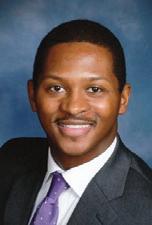
President, AMEA Collegiate Sarah Hicks (678) 986-1885 sehicks3@crimson.ua.edu
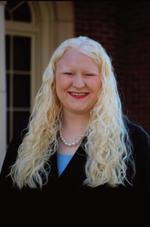

Industry Representative
Joey Harbison
Gadsden Music Company
607 Broad Street PO Box 132 Gadsden, AL 35901 205-910-2622
jmharbison@aol.com
Executive Director
Dr. Russell (Rusty) Logan 2020 Janabrooke Lane Auburn, AL 36830 (334) 663-1702



executive_director@myamea.org
Garry Taylor, Editor & Advertising Manager 1600 Manor Dr NE Cullman, AL 35055 (256) 636-2754 editor@myamea.org

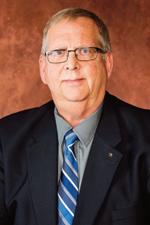
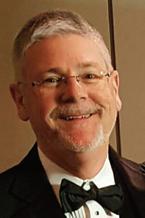

President-Elect
Dr. Phil Wilson
Ogletree Elementary School
737 Ogletree Road Auburn, AL 36830 (334) 538-9679 president_elect@myamea.org
Recording Secretary
Heather Holmes
Oak Mountain Middle School 5650 Cahaba Valley Road Birmingham AL 35242 (205) 682-5210 recording_secretary@myamea.org
President, AVA
Hilen Wilson
6315 Mary Harmon Bryant Drive Cottondale, AL 35453 (205) 454-3067 ava_president@myamea.org
Treasurer/Registrar
Pat Stegall
AMEA Registration PO Box 3385
Muscle Shoals, AL 35661
treasurer_registrar@myamea.org
President, ABA
Joel Henson
Pelham High School 2500 Panther Cir. Pelham, AL 35124 (205) 616-7478
jhenson@pelhamcityschools.org
President, ELEM/GEN
Sarah McLendon Hillcrest Elementary 400 E Watts St. Enterprise, AL 36330 (334) 313-2116
smclendon@enterpriseschools.net
AMEA Collegiate Advisor

Dr. Meghan Merciers University of North Alabama UNA Box 5040 142 Music Building Florence, AL 35632-0001 (256) 765-4518 mmerciers@una.edu
Assistant Executive Director Editor, Ala Breve



Garry Taylor 1600 Manor Dr NE Cullman, AL 35055 (256) 636-2754 editor@myamea.org

ADVERTISING & COPY DEADLINES
Fall - August/September (Back to School issue): July 15
Winter - October/November (Conference issue): September 15


Spring - May/June (All-State issue:) January 15
Summer - May/June (Digital Only issue:) April 15
President, HED Division Dr. Carly Johnson Alabama State University Department of Music 915 S. Jackson Street Montgomery, AL. 36104 (334) 229-4341
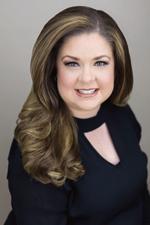
cjjohnson@alasu.edu
Alabama Department of Education Arts Education Specialist Andy Meadows 50 North Ripley Street Montgomery, Alabama 36104 (334) 694-4768
ameadows@ALSDE.edu
Unless otherwise indicated, permission is granted to NAfME members to reprint articles for educational purposes. Opinions expressed in this publication are not necessarily those of AMEA or the Editor. All announcements & submissions are subject to editorial judgement/revision.The Alabama Music Educators Association is a state unit of NAfME: The National Association for Music Education, a voluntary, nonprofit organization representing all phases of music education in schools, colleges, universities, and teacher-education institutions. Active NAfME/AMEA membership is open to all persons engaged in music teaching or other music education work.
Ala Breve is published four times a year (August, October, February & May) by the Alabama Music Educators Association and printed by Hardwick and Son Printing in Dothan, Alabama. Bulk rate postage paid at Dothan, Alabama.

Where is registration? This question was quite common on Thursday morning, but once our members found it, they discovered a very easy process! I would like to thank the membership for getting their NAfME dues paid before the conference. Because of your efforts, we have 1418 members! Attendance was up again this year with 1016 members checked in for the conference. I am sure there were a few members that missed the check-in process. Make sure you get your QR code scanned in the future, as soon as possible, because your PD is linked to it! If you did not check-in, you didn’t get the credit.
Thank you to Carl Hancock for his commitment to providing us with wonderful technology, and for his expertise in keeping it running smoothly. A special thanks to our Registration staff. We had many volunteers during the Thursday morning rush hour that helped us get the job done! Mary Ann, Carl, and Lauren were stellar as usual and the volun-
teer help from Heather Holmes and Greg Gumina was greatly appreciated! We found a great way to check in the members on the first morning. Thanks to our CNAfME members that stepped up and helped us for the first 3.5 hours! Having them during the rush was a great addition to the registration process. These CNAfME members gave up part of the conference to help: AJ Kell, Chris Wilson, Jenna Brown, JP Aufdemonte, John Niiler, Sam Sigal, Sarah Quinn Richet, Matthew Suit, Mariah Martin, Aleesa Parnell, and Mary Elizabeth Howze. We had 650 members checked in by lunchtime! A special thanks to Lauren Lingerfelt for being a registration assistant. She coordinated the students for the first part of the day and helped the rest of the time. At 4:00 pm on Thursday, we checked in our 900th attendee, Alyssa Watts. She was presented our 75th Anniversary commemorative pin and a photo-op! We will be in a different location next year as we move to Huntsville and you can be sure that we

will make more changes to the process as we strive to make it better every year!
1974 George Hammett
1975 Frances P. Moss
1976 S . J. Allen
1978 W. Frank McArthur
1980 Paul Hall
1982 Lacey Powell , Jr
1984 Johnny Jacobs
1986 Merilyn Jones
1988 Ronald D. Hooten
1990 Ken Williams
1992 Dianne Johnson
1994 James K . Simpson
1996 Johnnie Vinson
1998 Michael Meeks
2000 John McAphee , Jr
2002 Tony Pike
2004 Becky Rodgers
2006 John Baker
2008 Pat Stegall

2010 Steve McLendon
2012 Sara Womack
2014 Carl Hancock
2016 Susan Smith
2018 Greg Gumina
2020 David Raney
2022 Rob Lyda

ne thing that I love most about attending the AMEA conference every year is having the wonderful opportunity to connect with colleagues from across the state and to learn more about innovative ideas and methods being implemented in the classroom and in our rehearsal spaces. We were very excited this year to be able to feature outstanding HED clinicians, and experts in the field, who presented on a wide variety of topics including sessions on modern band pedagogy, commissioning projects for collegiate student chamber ensembles, the utilization of technology borrowed from athletics, and steps necessary for successful collaboration amongst colleagues and students. Looking ahead to next year, please do keep submitting your wonderful ideas and topics once the annual call for clinic session proposals goes out, as our community benefit so much by being able to share and learn from each other.
OSmith from Troy University. Lori’s piece, Opening Doors, is a three-movement work for flute and clarinet, performed by Dr. Whitney O’Neal and Dr. Meghan Merciers from the University of North Alabama. It commemorates when the State Normal School at Florence, now the University of North Alabama, first opened its doors to women in 1872. Robert’s piece, Teutonic Tales, is a three-movement work for tuba and piano, that was performed by University of Alabama D.M.A. student Tom Yan and pianist Dr. Kristofer Sanchack, that is inspired by Germanic and Nordic mythology and other figures in Teutonic folklore.

ture employment. Kudos to Dr. Jane Kuehne, from Auburn University, for her work in organizing this year’s sessions!


One of our newest contributions to the conference has been the new EdTPA Lesson Planning Competition, in partnership with the Collegiate Division and CNAfME student leadership. This competition serves as a collaborative opportunity for our collegiate CNAfME members to present and take part in meaningful discussion with seasoned members from the Higher Ed Division. The competition, really, more of a friendly and supportive showcase, allows for a stage on which our music education students can shine and acquire additional experience with the planning, preparing, and delivering of effective lesson plans. This year, there were three student finalists who were selected to present their lesson plans to the audience: Sawyer Strickland from Jacksonville State University, Siyu Tian from the University of Alabama, and Rachel Williams from Huntingdon College.
In addition to our wonderful clinicians and pedagogues, the HED division was able to present two showcase recitals featuring faculty and student performers from higher education institutions across the state, including Alabama State University, Auburn University, Huntingdon College, Jacksonville State University, Troy University, the University of Alabama, the University of Alabama at Birmingham, the University of Alabama in Huntsville, and the University of North Alabama. It was thrilling to have two Alabama composers in attendance to hear performances of their works: Dr. Lori Ardovino, from the University of Montevallo, and Robert W.
Being a conference that emphasizes professional development, it was wonderful to see current graduate students and emerging professionals shine in the spotlight when presenting their research and findings during the HED poster sessions. These types of opportunities are so valuable and important to gaining experience and confidence, in addition to providing valuable networking opportunities for fu-

In closing, I would like to take a moment to thank all of my wonderful colleagues who helped make this year’s conference a huge success. if you are reading this and desire to be part of, and take a more active role in a stimulating, inclusive, diverse community of academics, educators, and artists from across the state, then the HED Division is the place for you!
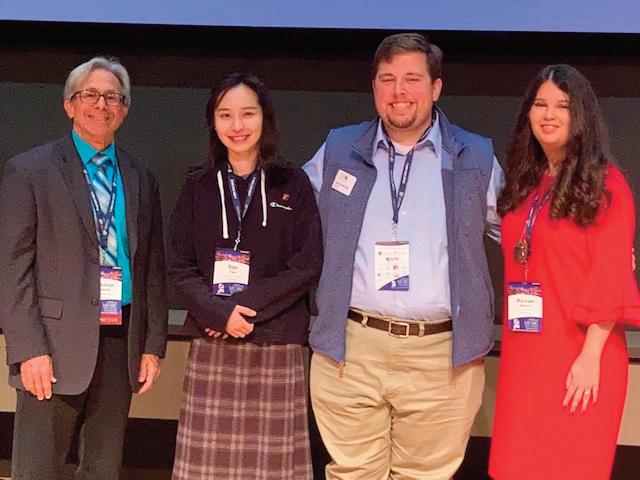

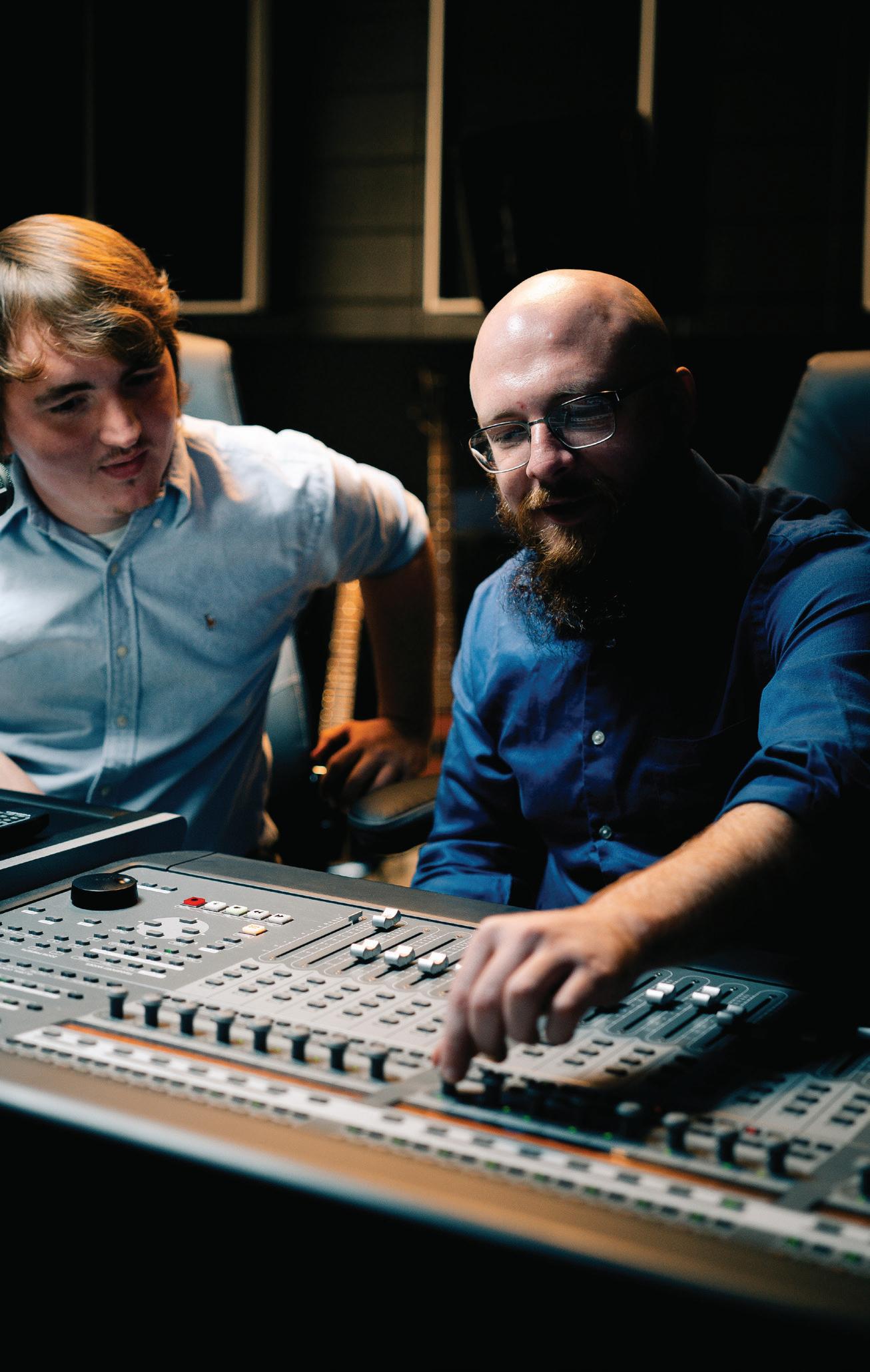










It was great to see so many of you at the AMEA conference. We enjoyed the wonderful sessions from Maria Ellis and many other presenters from across our state. I hope you were able to take away some new ideas and strategies to use with your choirs.
We also enjoyed performances by the Buckhorn High School Bella Voce, Florence High School Chamber Choir, Iron City Singers, the University of Alabama at Birmingham Concert Choir, and the Miles College Choir as well as lobby performances from Gardendale High School and Pinson Valley High School. The performances were a wonderful showcase of the thriving choral music that is occurring throughout our state. A special thank you to Jody Powell from St. Paul’s Episcopal School for supplying choral risers and a shell for the performances. I encourage you all to apply to perform and present at next year’s conference in Huntsville.
If you have not already done so, please complete the post-conference survey sent to you from AMEA. The conference is moving to Huntsville in 2024 and I know the feedback will be greatly appreciated as we move to a new venue.
During the general membership meeting at AMEA, the membership voted to
disband the Outstanding Accompanist competition. We also discussed the removal of our honor choir. However, the membership voted to table the discussion until our next meeting to research an immersion choir format.
A proposal to include community choir students that do not have a school choral program was discussed. The board will revisit this proposal at our summer board meeting to confirm details and qualifications.

There was also discussion on a proposal to include sight reading in the All-State audition process. The discussion included many ideas about the audition process as a whole. I encourage you to complete the Google form that was sent via email to have your thoughts heard and considered as we review our audition process.
I appreciate everyone having productive discussions at these meetings. The AVA board is always thriving to improve our events and provide the best opportunities for our teachers and students, and I am thankful that we can have constructive conversations while working toward that goal.

Thank you to Cameron Weiler for coordinating our new online audition process. We had approximately 80 students audition over the two days and I appreciate all of our students and directors for being flexible and navigating a new process. If you have any feedback about the process, please let us know. The All-State Show Choir Festival will be held at Spain Park High School on April 12-14.
I am looking forward to seeing you all at the All-State Choral Festival on March 911 at the Birmingham Jefferson Convention Complex. I am excited for our

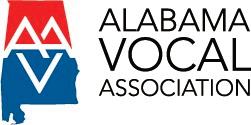
conductors Francisco Nunez, Meredith Bowen, Jose Rivera, Charlotte Botha, and Bridget Sweet. This year, we are thrilled to have as our guests at convocation, the Jacksonville State University Choir under the direction of Dr. Eliezer Yanson and the Alabama State University Choir under the direction of Dr. Kristofer Sanchack.
Communication will be sent via email from our President-Elect, Amanda Slay, with rehearsal assignments, procedures, and schedule.

Deadlines for State Choral Performance Assessment and Solo and Ensemble are quickly approaching. Please be sure to register early to secure your preferred performance time.
If you have not already done so, please complete the Google form sent via email from AVA. Your feedback is valued and appreciated and truly helps the AVA board in the planning and execution of our events.
I hope that your semester is going smoothly and is filled with beautiful music-making with your students. I look forward to seeing you at All-State. As always, if you have any questions, suggestions, or concerns, please contact me at hilen.wilson.ava@gmail.com
Thank you, Hilen
WilsonSATB CHOIR:
Francisco J. Núñez, a MacArthur Fellow and Musical America’s 2018 Educator of the Year, is a composer, conductor, visionary, leading figure in music education, and the artistic director/founder of the Young People’s Chorus of New York City, renowned worldwide for its diversity and artistic excellence. Since its founding in 1988, Mr. Núñez has created recognition among composers of the child’s voice as a significant instrument for making music. Mr. Núñez also leads the University Glee Club of New York City, its fifth conductor since the all men’s chorus was established in 1894; the principal conductor of American Young Voices concerts of schoolchildren performing in some of the largest arenas in the Northeast; and is sought after nationwide as a guest conductor by professional orchestras and choirs and as a master teacher. In addition, through YPC National he is expanding the YPC model to children’s choruses beyond New York City and is a frequent keynote speaker as a leading authority on the role of music in achieving equality and diversity among children in today’s society. Mr. Núñez composes countless compositions and arrangements in all musical formats and styles for choirs, orchestras, and solo instruments and has received an ASCAP Victor Herbert Award, the New York Choral Society’s Choral Excellence Award, and the Visionary Award from Bang on a Can. ABCTV honored him as its “Person of the Week,” and Musical America Worldwide named him among 30 “Influencers” for his contributions to the music industry. NYU Steinhardt has presented him with its Distinguished Alumnus Achievement Award, and he holds honorary Doctor of Music degrees from both Ithaca College and Gettysburg College.

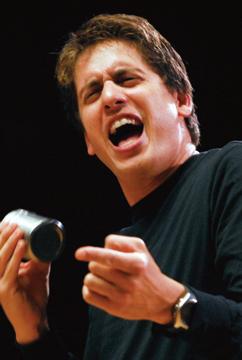
SSA CHOIR:
Dr. Meredith Bowen is a nationally recognized conductor-teacher, scholar, and singer whose work empowers students to find their voice through culturally relevant teaching and music-making. As the Director of Choral Activities at Radford University in Radford, VA, she conducts three ensembles and teaches undergraduate

and graduate classes in choral conducting, vocal pedagogy, choral methods, choral literature, and supervises student teachers. She serves on the Choral Advisory Council for the Institute for Composer Diversity, as President-elect for the Virginia chapter of the American Choral Directors Association, is an inaugural member of, and Artistic Administrator for, mirabai, a professional women’s ensemble, and is on faculty for the Choral Music Experience Institute and the Virginia Governor’s School for the Visual and Performing Arts and Humanities. Bowen is an active guest conductor, clinician, and presenter. Her recent conducting invitations include all-state honor choirs in Michigan, Virginia, and Kansas; and honor choirs from Alaska to Kenya to Carnegie Hall. She was one of six conductors selected to represent the United States by the American Choral Directors Association International Exchange Program in Nairobi, Kenya. Bowen’s two current scholarship interests are restoring, publishing, and performing music written by 17th-century women and the impact of socially-conscious programming. She presented her research on restoring convent music at the National American Choral Directors Association Conference and contributed an article on the same subject in the Choral Journal. Four of her restored editions are published by Boosey & Hawkes and two editions appear on the mirabai ‘s inaugural recording, “ecstatic songs.” She is slated to conduct the premiere of the second movement of Andrea Clearfield’s “Home in Me” with a treble honor choir at Carnegie Hall produced by National Concerts. Previous to her appointment at Radford, Bowen taught K-12 general music, choir, and band in Lansing, MI, and was the Artistic Director of multiple ensembles in Michigan including Sistrum - Lansing Women’s Chorus, Holland Chorale, and the Battle Creek Girls Chorus. Bowen holds a B.S. in Music Education from West Chester University, an M.M. and a D.M.A. in Choral Conducting from Michigan State University.
TTBB CHOIR:
Dr. Charlotte Botha is the Director of Choral Activities at Hamilton College in Clinton, NY, where she conducts the College Choir and the Hamilton Voices choral theater ensemble. She is a passionate teacher of music theory and social justice

musicology. She has worked extensively with mixed and equal-voice singers from various backgrounds. Her tenure as conductor of the Drakensberg Boys Choir solidified her passion for making music with and composing for young singers. She has performed and presented workshops around the globe, most notably as a member of the World Youth Choir alumni group TIME Ensemble. Her research interests include phonetics, choral text-painting, and equitable practices for including the music of and by marginalized communities in choral programs. She holds a DMA from The University of North Texas, an MMus from Nelson Mandela University, and a BMus from the University of Pretoria.
MS MIXED CHOIR:
Dr. José Rivera, Professor of Choral Music Education at the University of North Carolina- Pembroke serves as the Coordinator of Music Education and conducts the University Chorale. Prior appointments include the University of Wisconsin-Milwaukee and director of choral activities at Lawton Chiles High School and James Rickards High School in Tallahassee, Florida. Dr. Rivera has conducted AllDistrict and Honor Choirs at the district, state, and regional levels. He recently led a performance of the Latin-American Honor Choir Cantaré at the ACDA Southern Region Conference and has conducted All-State choirs in North Carolina, Florida, and Alabama. He has guest conducted and presented at the Universidad National Autónoma de Mexico (UNAM) and Universidad de Las Americas (UDLAP) in Mexico, Instituto Superior de las Artes in Cuba, Universidad de Mendoza in Argentina, and the DoDEA High School Chorus Festival in Oberwesel, Germany. His research areas include teacher preparation and Global Music with a focus on the music traditions of Latin America and has presented choral clinics and lectures at state, regional, and national American Choral Director Association and the National Association for Music Educators conferences. Dr. Rivera received his Ph.D., MM.E, and undergraduate degrees in Music Education and Conducting from Florida State University. During his tenure in Florida, he was a successful public music teacher at the elementary, middle, and high school levels where his advanced choirs
received various regional and national awards. Dr. Rivera served as ACDA National R&R Chair for World Musics and is currently the NC-ACDA President-elect. He thoroughly enjoys preparing future music educators in North Carolina.
MS TREBLE CHOIR: Bridget Sweet is an Associate Professor of
Music Education at the University of Illinois in Urbana-Champaign, Illinois where she teaches music education pedagogy, including choral methods and literature, middle-level general music methods, graduate courses in music education, as well as a course focused on the development of healthy practices for all musicians. Dr. Sweet has worked extensively with adolescent singers as a teacher, clinician, and adjudicator. She wrote the books Growing Musicians: Teaching Music in Middle School and Beyond (2016) and Thinking
Outside the Voice Box: Adolescent Voice Change in Music Education (2019). Her research interests include middle-level choral music education, female and male adolescent voice change, empowering music educators, health and wellness, and intersections of diversity and the music classroom. She is earning licensure to be a Body Mapping Instructor through the Association for Body Mapping Education.

Thursday, March 9, 2023
12:00-12:45 pm
Student Registration in Assigned Rehearsal Rooms
MS Treble, North Meeting Rooms G-I
MS Mixed, North Meeting Rooms C-E
HS SSA, Forum A-B
HS TTBB, Forum Theater
HS SATB, Forum G-I
12:00-2:00pm
1:00-4:30 pm
Director Registration, Forum C
Rehearsal, assigned rehearsal rooms
4:30-7:00pm Dinner Break
7:00-9:30 pm Rehearsal, assigned rehearsal rooms 11:00pm Curfew
Friday, March 10, 2023
8:30-9:45 am
MS Treble Rehearsal, North Meeting Rooms G-I
MS Mixed Dress Rehearsal, Concert Hall
HS SSA, Forum A-B
HS TTBB, Forum Theater
HS SATB, Forum G-I
8:45-9:45 am
10:00-11:15 am
AVA General Membership Meeting, North Meeting Rooms C-E
MS Mixed Rehearsal, North Meeting Rooms C-E
MS Treble Dress Rehearsal, Concert Hall
HS SSA, Forum A-B (cont.)
HS TTBB, Forum Theater (cont.)
HS SATB, Forum G-I (cont.)
11:15 am-1:15 pm
1:15-2:15 pm
2:30-4:15 pm
Lunch Break
Convocation, Concert Hall
MS Treble, North Meeting Rooms G-I (final MS rehearsal)
MS Mixed, North Meeting Rooms C-E (final MS rehearsal)
SSA Rehearsal, Forum A-B
TTBB Rehearsal, Forum Theater
SATB Dress Rehearsal, Concert Hall
4:30-6:00 pm
SSA Dress Rehearsal, Concert Hall
TTBB Rehearsal, Forum Theater (cont.)
SATB Rehearsal, Forum G-I
7:00 pm Call Time for Middle School Concert
7:30 pm Middle School Concert, BJCC Concert Hall
Saturday, March 11, 2023
9:45-11:15 am
11:15 am
12:00 pm
SSA Warm-Up, Forum A-B
TTBB Dress Rehearsal, Concert Hall
SATB Warm-Up, Forum G-I
Doors Open to Audience
High School Concert
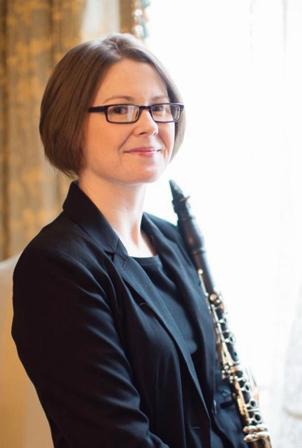

Attending the 2023 Alabama Music Educators Association Professional Development Conference as a collegiate student is an exciting and inspiring experience. Taking a weekend to escape the confines of the music building and entering a world of like-minded people living our goal is a magical experience. Here is just a brief overview of the fantastic things that our collegiate members got to experience this year.
Did you know?
126 cNAfME Membersregistered and attended AMEA. cNAfME hosted three collegiateevents at AMEA: the Collegiate Mixer and edTPA Competition (in collaboration with HED) and the Collegiate Luncheon. Students from the University ofAlabama, Troy University, University of Montevallo, Auburn University, Samford University, Faulkner University, Alabama State University, Jacksonville State University, and Huntington College all attended the luncheon. For the first time, collegiatesassisted with registration and met many of our state educators individually!
The Executive Boards of cNAfME and HED hosted the Collegiate Mixer in the Sheraton Ballroom on Thursday, January 19, 2023. While enjoying lemonade, chips, and other light snacks, the collegiate students enjoyed filling out an icebreaker BINGO card that encouraged
socializing and connecting with students from all the different colleges and universities represented.
Combine food with the opportunity to connect with other aspiring music educators around the state, and you get 60 awesome cNAfME members that attended the Collegiate Luncheon this year. The luncheon began with announcements from Professor Susan Smith (Collegiate Advocacy Council for NAfME and Southern Division President-Elect), Dr. Rob Lyda (AMEA President), and a special appearance by Dr. Deb Confredo (NAfME National President-Elect)! Our guests highlighted upcoming national events, including the cNAfME Zoom chats hosted by the Advocacy Board and the Collegiate Advocacy Summit, which will occur for the first time in person in three years in Washington, DC, this June! Dr. Lyda
asked us to write postcards for our legislators so we can hand them out on Hill Day in Montgomery, Alabama, on March 21, 2023. Finally, Dr. Deb Confredo inspired our members with a great speech about how much her MEA experiences impacted her as a student.

2022 President Mariah Martin presided over a full chapter meeting. Proceedings included the passing of an amended cNAfME Constitution and Bylaws, the election of the 2023 Executive Board, and the formation of a new GroupMe Chat where members from across the state can communicate with each other and share their adventures in music education! Please stay tuned for a QR code in our post-conference email to sign up.


AL cNAfME hosted thought-provoking sessions this year full of excellent content, presented by educators from

 Sarah Hicks, President, Alabama cNAfME
Sarah Hicks, President, Alabama cNAfME
secondary to higher education, including the 2nd Annual edTPA Competition (hosted with the HED Division). The prize is a year’s membership to the AMEA! There were three outstanding finalist presentations on Saturday, January 21, 2023, and the winner was Sawyer Strickland of Jacksonville State University.
We would like to extend a special thank you to Mariah Martin for her incredible leadership and the 2022 eBoard. The knowledge acquired, the connections made, the number of career-changing experiences, and the leadership developed at the 2023 AMEA Professional Development Conference will leave a lasting impression on the Collegiate Division! We look forward to what the new year brings, hopeful and inspired by the promise of a bright future and wish for even more collegiates from all over the state to attend next year.
Sarah Hicks, 2023 President (The University of Alabama)
Mariah Martin, 2022 President (The University of Alabama)
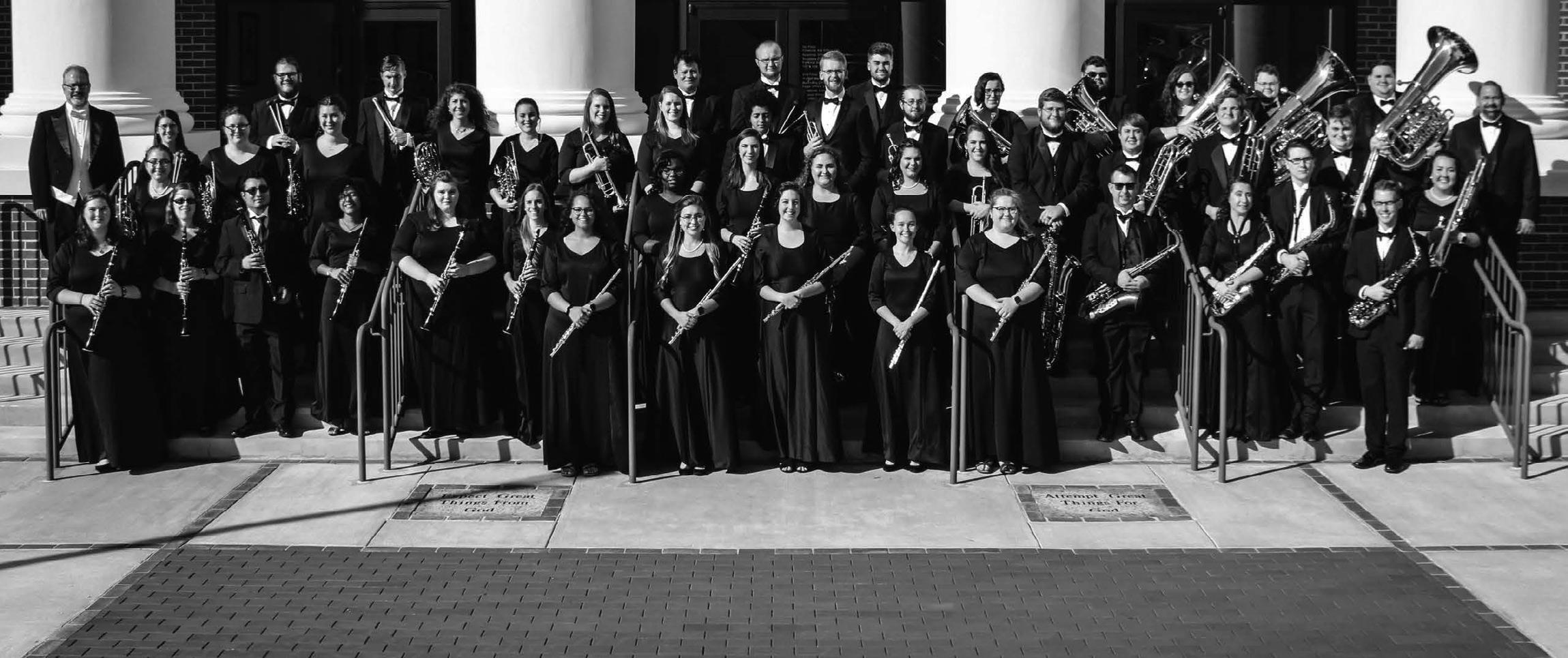
Matthew Suit, President-Elect (Troy University)
Kensley Fuller, Secretary (Troy University)
Reid Sayle, Treasurer (The University of Alabama)
Dr. Meghan Merciers, AL cNAfME Advisor
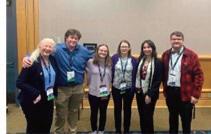



Rucker Rhythms - What did performing at AMEA mean to you?

“Performing at AMEA showed me that even though I’m young and little, I can make a big impact on people’s lives.”
- AniaLloyd, 6th grade
“What it means to me is that whatever happens, somebody’s there for you.” - DeKadra Richardson, 6th grade
“It means a lot because performing for other people means you can succeed in life.” - Natalia Crislip, 5th grade
“It was amazing. It meant the world to me.” - Kate Delgado Gomez, 4th grade
“I am grateful for the opportunity performing at AMEA afforded my students. We have an important message to share, and are thankful for AMEA providing a platform to do just that.” - Andrea Marsh, Rucker Rhythms director

Rhonda Tucker - “ What an amazing time I had singing, playing, dancing, and learning with my Alabama colleagues after being away for 15 years. Sandy Lantz and Gretchen Wahlberg’s sessions incorporated activities involving recorder, ukuleles, barred and unpitched instruments. Their children’s literature connections were my favorite. John Jacobson introduced the JJ and Me Experience with fun movement activities and performance pieces for the entire school year. His energy is infectious! Tiffany Strickland showed this old dog innovative ways to incorporate visuals and props using Kodaly. I learned so much, but the best part of this conference was being home with my Alabama Elementary Music Teacher family. I treasure these times to connect with my friends and to make new ones. Thank you AMEA Elementary Board for planning a wonderful conference! Can’t wait for AMEA 2024!”

Holly Seales - “It was wonderful to have the opportunity to come back to AMEA after missing it the past 3 years. I thoroughly enjoyed all of the sessions with John Jacobson (I’m a huge fan) and Sandy & Gretchen! I also enjoyed meeting and chatting with NAfME President-Elect Deb Confredo and listening to many featured performers. All this combined with fellowship among colleagues and reuniting with old friends has inspired me! Our AMEA leadership did a fabulous job this year and I cannot wait to come back in 2024!”
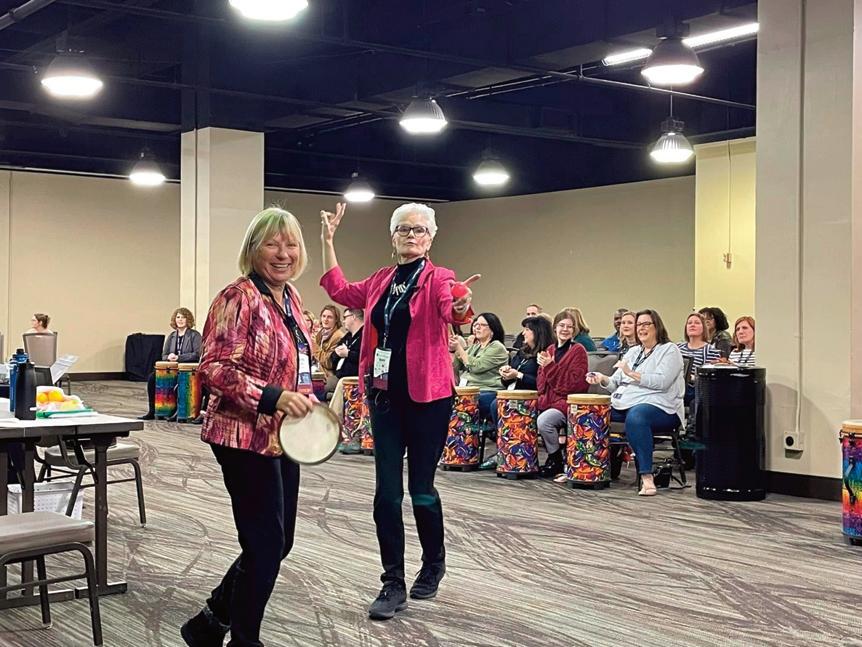
Anna Kelley - “As a new teacher, I always love going to the AMEA conference! It always had wonderful workshops with amazing ideas that I can use in my classroom. It also is a great place to meet new people and visit with friends from the music education community.”
Kristen MacQueen - “Every January I look forward to AMEA. It’s a time to collaborate, visit, and enjoy wonderfully talented educators and their performances with their students. Elementary music teachers are a different breed and we embrace all the crazy. We love what we do as educators and hope we pass that love on to our students. Dance, sing, and play isn’t just in the classroom, it’s life!”
Thank you so much to everyone who helped make this a wonderful conference! Your Elementary/General officers did a great job preparing everything. If you were unable to attend, you can still view the handouts in the Guidebook app.

“I loved singing in our performance because it made me feel like I don’t have to worry about anything going on in my life.” - Harper Rainbolt, 5th grade
“When I stood up there on the stage, I left proud. I felt a wave of sound move through my body. My heart bursts with joy. I see my parents clapping for me. I sang like I meant it. When we were done singing, I felt like I accomplished my goal.” - Maadhev Karthikeyan, 5th grade
“Performing at AMEA was a wonderful experience for both me and my students. Preparing made us push ourselves, and ultimately made us very proud of the hard work it took to get there.” - Lisa Latham, Trace Singers, director

As we begin to plan for next year, we would love to have you present a session. What are you passionate about? What would you love to share with others? What do you do in your classroom that would be helpful to others? We would also love to have an elementary group perform. Do you have an Orff ensemble or choir? Bucket drummers or recorder ensemble?
Huntsville 2024, here we come!





The 2023 AMEA Conference was truly one to remember. I’ve been attending this conference for over 20 years. I can say, without hesitation, this year was my favorite. I had the opportunity to pop into almost every clinic and performance and was extremely pleased with our offerings. It was so nice to see colleagues supporting one another. We are a part of a very awesome profession. That was on display at its finest at AMEA 2023.
This year’s conference was filled with outstanding performances. The opening concert was presented by the Oak Mountain Percussion Ensemble under the direction of Kevin Ownby. This concert was truly a great way to kick off the ABA performances at this year’s conference. The next ABA performance block featured the Smiths Station High School Symphonic Band (Gene Butler) and Rehobeth High School Symphonic Band (Marc McLendon). We then wrapped up Thursday with outstanding performances by the Daphne High School Wind Ensemble (Jamar Dumas), Muscle Shoals Middle School (Daniel Seay), and Hoover High School Symphonic Winds (Ryan Fitchpatrick). Our Friday performances included the UAB Wind Symphony (Sean Murray), Auburn Junior High School Wind Symphony (Joshua Wine), and the Huntsville High School Wind Ensemble (Stuart Tankesley).
We often think of AMEA performances as a milestone for band directors. However, you could look at the faces of the performers in these ensembles and see that it was so much more. Students are the most important part of our journey. If they stay at the center of all of our decisions, they are impacted more than we realize.
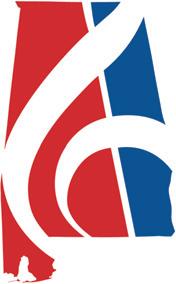

When you read this article, it is my hope that district-level All-State auditions are complete and we are moving toward our All-State event on April 27-29, 2023 at our new venueThe Von Braun Center in Huntsville, Alabama. As a reminder to our membership, auditions for this event will be held virtually using the Heartout app. Also, preliminaries of the All-State Solo Festival will be submitted virtually through the Heartout app. You can find complete information about this year’s festival on our website: www.alaband.org




Good luck with your MPA preparations. Remember, it’s not about the rating; it’s about the journey.

Frank Ticheli's music has been described as being “optimistic and thoughtful" (Los Angeles Times), “lean and muscular" (New York Times), “brilliantly effective" (Miami Herald) and “powerful, deeply felt crafted with impressive flair and an ear for striking instrumental colors" (South Florida Sun-Sentinel).
Ticheli joined the faculty of the University of Southern California's Thornton School of Music in 1991, where he is now Professor of Composition. From 1991 to 1998, Ticheli was Composer in Residence of the Pacific Symphony.
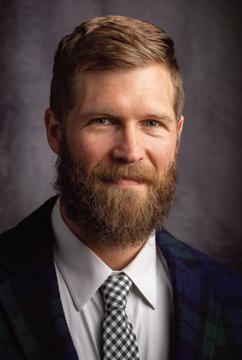

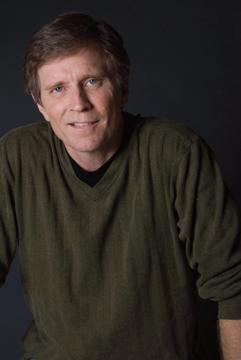
Ticheli’s orchestral works have received considerable recognition in the U.S. and Europe, with performances by the orchestras of Philadelphia, Atlanta, Detroit, Dallas, Nashville, Stuttgart, Frankfurt, Saarbruecken, and many others. He is best known, however, for his works for wind ensemble and concert band, many of which have become standards in the repertoire.
Dr. Rebecca Phillips is Professor of Music and Director of Bands at Colorado State University where she conducts the CSU Wind Symphony and guides all aspects of the band and graduate wind conducting programs. Prior to this appointment, she served as the Associate Director of Bands and Director of Athletic Bands at the University of South Carolina where she was responsible for directing the Symphonic Winds Concert Band, “The Mighty Sound of the Southeast” Carolina Marching Band, “Concocktion” Pep Bands, teaching undergraduate instrumental conducting, and directing the Carolina Summer Drum Major Clinic.
A native of the Washington, D.C. area, Dr. Phillips earned her Bachelor’s degree in Music Education from The Florida State University, Master of Music degrees in conducting and trombone performance from the University of South Florida, and a Doctorate of Musical Arts in conducting at Louisiana State University. She served as a secondary school band director for seven years in Florida, including Director of Bands at Howard W. Blake Performing Arts High School in Tampa, Florida where she developed an award-winning concert band program. Currently, she is the President of the National Band Association, chair of the Music Education Committee for the College Band Directors National Association, and co-chair of the American Bandmasters Association Commissioning Committee.
Benjamin Lorenzo is an associate professor of music and the Director of Bands at Kent State University's Glauser School of Music where he conducts the Wind Ensemble, teaches conducting, and provides leadership for university bands. Previously, he served as Associate Director of Bands and Director of Athletic Bands at the University of Arkansas where he led the Razorback Marching Band and Wind Symphony. Before this appointment, Lorenzo held positions at Oklahoma State and Texas Tech University. His teaching experience also includes high schools in Florida and Texas.
Lorenzo holds the Doctor of Musical Arts and Master of Music degrees in Wind Conducting from The University of Texas at Austin under the tutelage of Jerry Junkin. He received a Bachelor of Music degree in Trombone Performance from Florida International University, studying with Mark Hetzler. A native of Havana, Cuba, he is a proud alumnus of Miami-Dade County Public Schools, where he began his teaching career.
Dr. Arris Golden is the Assistant Director of Bands and Associate Director of the Spartan Marching Band at Michigan State University. In this capacity, Dr. Golden teaches courses in conducting, marching band techniques, conducts the Spartan Youth Wind Symphony, is coordinator of the MSU Performing Arts Camps, and assists with all aspects of the athletic band program. Before joining the faculty at Michigan State University, Dr. Golden was a member of the conducting faculty at the University of North Carolina at Chapel Hill, where she served as the Assistant Director of University Bands. Prior to her collegiate appointments, Dr. Golden had a distinguished 18year teaching career in the public schools of North Carolina. In her last public school assignment, Dr. Golden conducted the premiere of four commissioned works that have become standards in the middle school band repertoire: “Kitsune: The Fox Spirits,” by Brian Balmages (2009), “The Machine Awakes” for young band and electronics by Steven Bryant (2012), “Freight Train,” by Pierre LaPlante (2013), and “The Cave Your Fear” by Michael Markowski (2014).
Dr. Golden holds degrees from the University of North Carolina at Chapel Hill and the University of North Carolina at Greensboro. She completed the Doctor of Musical Arts in wind conducting from Michigan State University as a 2014 recipient of a Michigan State University Distinguished Fellowship.
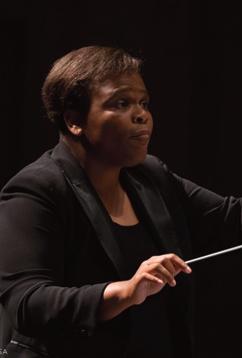

MS White Band
Jack Wilds is a composer and educator whose works have brought him into collaboration with musicians aged 5-95. Ranging from children's choirs to collegiate wind ensembles and professional chamber groups, Jack's music draws on visual art, philosophical and religious texts, poetry, and absolute musical influences to create vibrant works that meet performers where they are while inspiring authentic, artistic music making.
His chamber music has been performed by the Attacca Quartet, the University of Texas New Music Ensemble, the Austin Saxophone Ensemble, and members of the New York Philharmonic and the Atlanta Symphony. His works have also been featured at international festivals and composition workshops including the International Trombone Festival, the Slider Asia Clinic in Hong Kong, the American Trombone Workshop, the International Horn Symposium, New Music on the Bayou and The Wyoming Festival.
He has studied composition with Michael Ippolito at Texas State, and Chris Trapani and Donald Grantham at the University of Texas.
April 26, 2023 Solo Festival – Von Braun Civic Center Huntsville, AL
April 27-29, 2023 All State Band Festival, Von Braun Civic Center ABA Office Coat Check - South
Wednesday, April 26
 by Caleb Hilliard
by Caleb Hilliard
simple text allow children to activate different parts of their brains compared to simply reading or listening to text being read aloud. It would be advisable to make the listening experience interactive by letting students see the pages (perhaps enlarged and formatted into a slideshow for the sake of classroom visibility) and follow along as they listen to the performance.
Many other children’s books have been set to music, and in fact the nature of so-called “singalong books” may help students with sensory processing issues (such as autism spectrum disorder or even ADHD) to stay engaged during the reading. If your students struggle to process books being read aloud, consider trying a multisensory approach like a singalong book or a book set to music.

If you’re looking for books to incorporate into your elementary music classroom, one uncommon option is Margaret Wise Brown’s Goodnight Moon, a classic children’s book that has been a staple of my own childhood as well as many others’ dating back to its publication in 1947. While it doesn’t often see much use inside the music classroom, composer Eric Whitacre has set the text of the iconic children’s story to music in a variety of settings including wind ensemble, orchestra, piano (all of these with solo soprano voice), and SATB choir.
The plot of Goodnight Moon is an endearingly simple one. Per Smithsonian Magazine’s Amy Crawford:
“A young bunny says goodnight to the objects and creatures in a green-walled bedroom, drifting gradually to sleep as the lights dim and the moon glows in a big picture window. Goodnight Moon has sold more than 48 million copies since it was published in 1947. It has been translated into at least a dozen languages, from Spanish to Hmong, and countless parents around the world have read it to their sleepy children.”
While Whitacre’s setting of Goodnight Moon may be a bit too advanced for young learners to sing themselves, the lullaby-like melodies, soothing harmonic language, and
Have fun!
Caleb
HilliardCaleb Hilliard is a native of Athens, Alabama, and holds a bachelor’s degree in music with a concentration in clarinet performance from the University of Alabama at Birmingham. Caleb is a former Marching Blazers drum major as well as the principal clarinetist of the UAB Wind Symphony. His versatility across the clarinet family has allowed him a healthy career performing professionally across the state of Alabama in orchestras, wind bands, chamber ensembles, and as a soloist. Caleb is also a seasoned conductor and teacher, formerly for the Madison City Youth Orchestra and now as a graduate teaching assistant for the UAB Wind Symphony, Symphony Band, Marching Blazers, and clarinet studio. He maintains a private clarinet studio and is a frequent clinician and instructor across central Alabama. Caleb is entering his final semester pursuing a master’s degree in music education at the University of Alabama at Birmingham, where he studies with his clarinet mentor Dr. Denise Gainey and his conducting mentors Dr. Sean Murray and Dr. Cara Morantz.

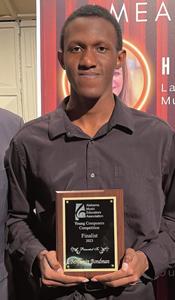








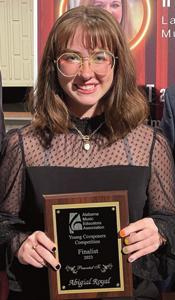

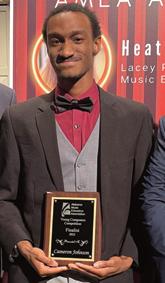











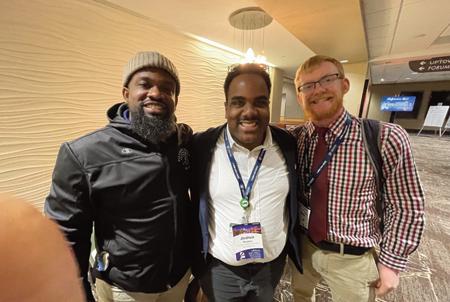
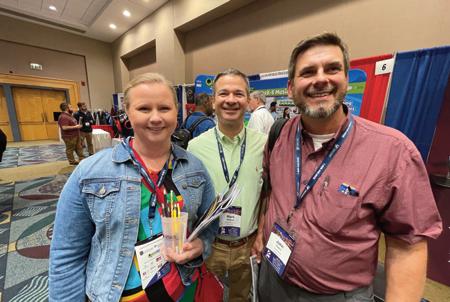

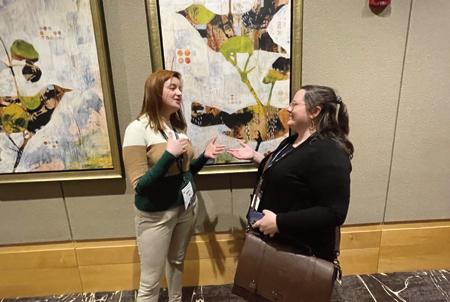

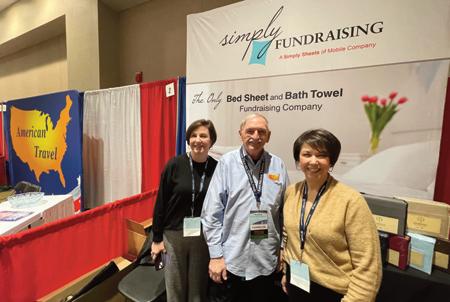

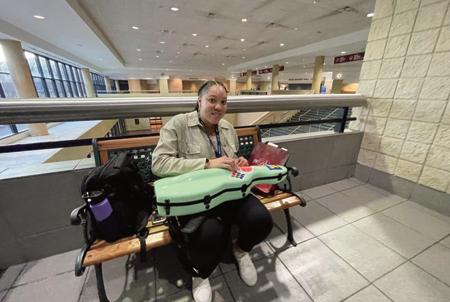
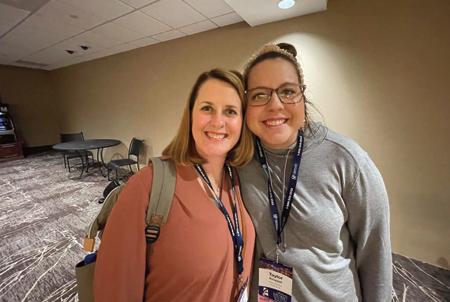













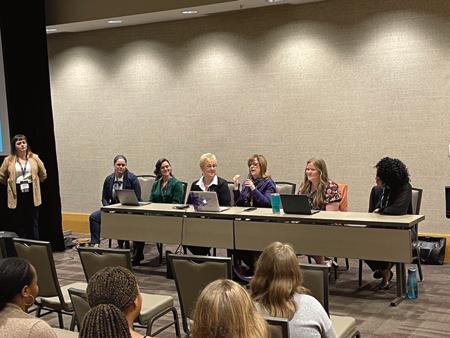

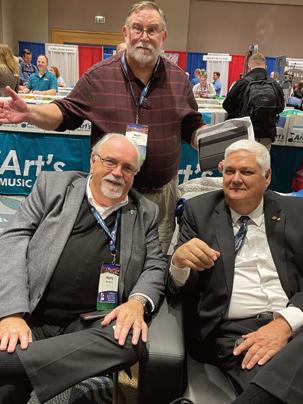



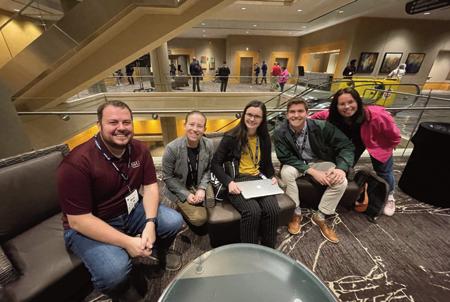

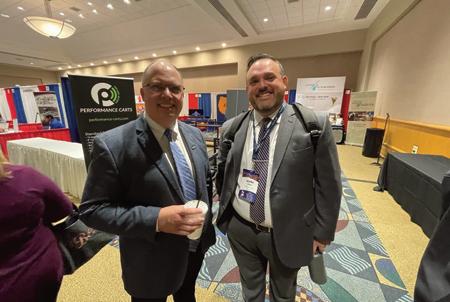



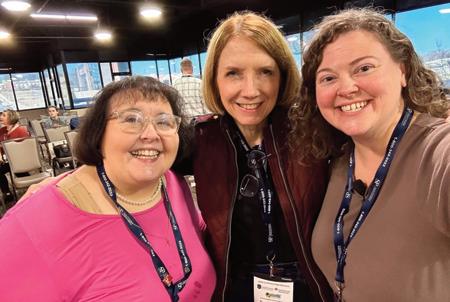






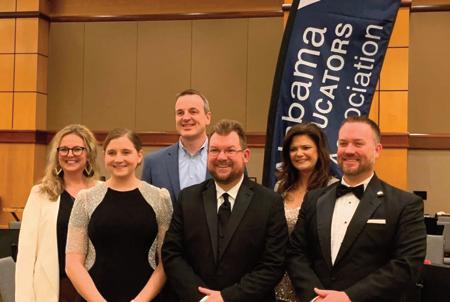


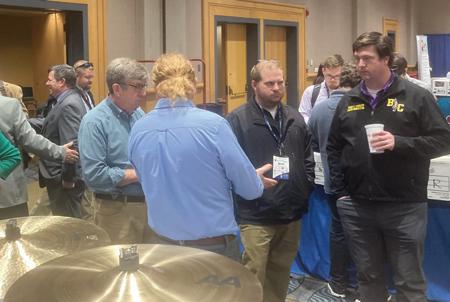

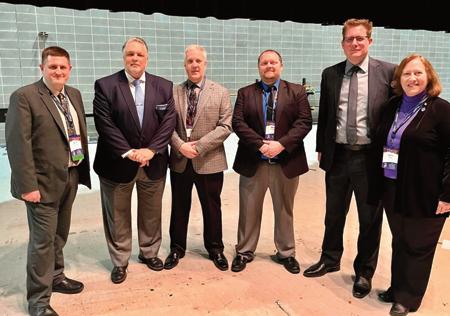












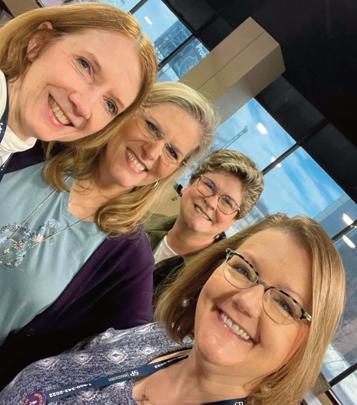
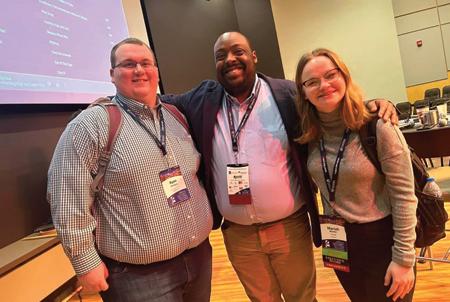




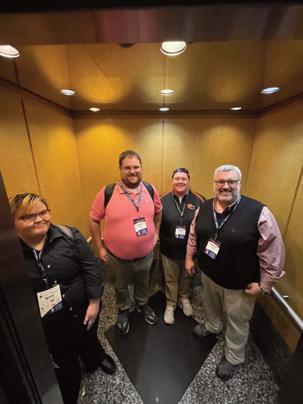



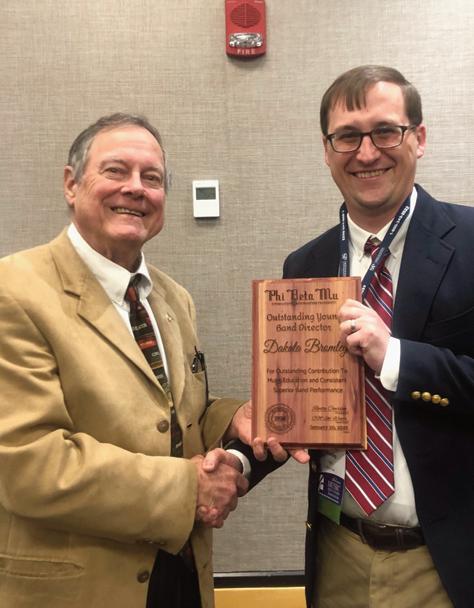


 New Phi Beta Mu Member Deanna Rizzo pinned by sponsor Dane Lawley
New Phi Beta Mu Member Gene Butler and sponsors Rusty Courson & Susan Smith
New Phi Beta Mu Member Justin Ward and sponsors William Connell, Jon Bubbett, and Joel Henson
Phi Beta Mu Outstanding Young Band Director Dakota Bromley congratulated by Ski Winter (L)
New Phi Beta Mu Member Deanna Rizzo pinned by sponsor Dane Lawley
New Phi Beta Mu Member Gene Butler and sponsors Rusty Courson & Susan Smith
New Phi Beta Mu Member Justin Ward and sponsors William Connell, Jon Bubbett, and Joel Henson
Phi Beta Mu Outstanding Young Band Director Dakota Bromley congratulated by Ski Winter (L)
Members of the Alabama Orchestra Association,
Iam so pleased to report that, thanks to you and your incredible students, 2023 has gotten off to an incredible start! On the first weekend of the new year, January 7-8, 2023, a total of 235 Alabama orchestra students converged upon Huntsville and Prattville for the North and South Region Orchestra Festivals. Suren Petrosyan (University of North Alabama) and Alex Fokkens (Alabama School of Fine Arts) led the students in the North, and Michael Gagliardo (Etowah County Youth Orchestra) and Anne Witt (University of Alabama) led the students in the South. I am grateful for the volunteers that made both festivals run smoothly. I am also grateful to all the folks at the Randolph Upper School (Huntsville) and Prattville High School for their generous hospitality.
Thank you to everyone that was able to attend the 2023 AMEA Professional Development Conference in Birmingham, January 19-21! We had a ball and learned so much! In case you were not able to attend, Dr. Sidney King, Professor of Double Bass at the University of Louisville, was our headliner. He is an accomplished pedagogue, clinician, soloist, and composer. He is also an incredibly kind and generous person and had so much to offer string and orchestra teachers across our great state. In addition to Sidney’s sessions entitled “Bass-ic Issues in the String Classroom,” “Teaching Double Bass Technique Through Orchestral Excerpts for the Beginning and Intermediate Bassist,” “Bow Strokes and Right Arm


AMEA First Annual Hill Day: March 21, 2023
Alabama State Capitol, Montgomery, Alabama
Orchestra Music Performance Assessment: April 14 - 15, 2023
Thompson High School, Alabaster, Alabama
#ala4musiced
alabamaorchestraassociation.org

Pedagogy,” and “Shifting for Low Strings: A Classroom Approach,” we also learned how to manage minor confrontations with confidence, how to reimagine our rehearsal dialogue, how to write grants for our programs, and how to lead with confidence from the podium. The AOA Chamber Orchestra lobby performance and the J.W. Pepper string orchestra reading session were icing on the proverbial cake!
In October and November of 2022, 411 students from across the state auditioned for the 2023 Alabama All-State Orchestra Festival, which took place February 9-12, 2023, on the campus of the University of Alabama. Steven Gooden, the Assistant Conductor of the Chicago Youth Symphony Orchestra, led the Festival Orchestra. Bruce Walker, the Associate Professor of Music at Columbia Basin College in Pasco, WA, and Music Director for the Walla Walla Symphony Youth Orchestra, led the Sinfonia. Katarzyna Bugaj, Associate Professor of String Music Education in the College of Music at Florida State University, led our Consort String Orchestra. At the 2023 All-State Orchestra Festival, our programs consisted of traditional works, modern works, works by female composers and composers of color, and works that highlighted mental health and social justice issues. Thank you to all of our volunteers that made All-State Orchestra 2023 a success!
String and orchestra educators, thank you for all that you do to ensure that orchestral music thrives in the State of Alabama. May we strive to build musical communities where our students find safe spaces to express themselves, their experiences, their hopes, and their dreams for a kinder world where all are loved, nurtured, and supported. May this be our mission and may music be our vehicle.
Musically yours, Joseph Lee President, Alabama Orchestra Association
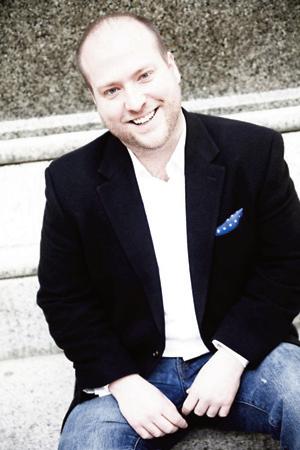
Is there a more heart-wrenching statement for a music educator to hear than, “My parents said I can’t join; they can’t afford an instrument?” Unfortunately, this is a sad reality in music rooms across the nation. Students from lower socio-economic backgrounds are oftentimes unintentionally deprived of a wellrounded education due simply to the inability to access it, when often they need arts education the most.
Not only are students often unable to participate, but school districts may even try to save money by cutting their music programs altogether. Unfortunately, this is likely to happen in areas with less funding, particularly Title 1 areas.1 (A title 1 school receives federal funding to compensate for lower-than-average family income, requiring at least 40% of students to be on free/reduced lunch for the school to qualify).2 Even with additional funding, it is difficult for these schools to keep up, often cutting music or art, particularly in elementary and middle school, as seen in the first
citation. This clearly impacts the type of education students receive and may also shape community attitudes, with music programs being seen as less essential than “core” subjects or sports, making fewer and fewer students have an interest to participate.
The schools lucky enough to maintain music education still have innumerable adversities to solve. Recruiting can be difficult, as stated at the beginning of the article, due to the misconception band/orchestra is expensive (we all know they can be), without even looking at the options available. The costs of maintenance for students’ equipment that do join is another factor, along with other fees for the families (such as travel or uniform cleaning). These schools obviously have limited funding and they often may experience issues with fundraising. Fundraising may be difficult to do in low-income areas when many parents are simply trying to pay bills and do not have discretionary money. Sadly enough, this may also push educators away from these schools, creating
teacher retention problems and a large turnover rate. All the issues above make it difficult to focus on what should be the center of the classroom: making music. However, in these situations it is more important than ever to persevere and attempt to provide students with quality education.

Along with the obvious positive of being able to play and read music, music programs can provide beneficial life skills and chances for students to develop them. Things like time management, communication, teamwork, and commitment are some of the more general ones that students often may not learn in a traditional classroom setting or at home. Being involved in after-school programs has also been proven to be extremely beneficial to at-risk youth, allowing them to be occupied in a productive way and make plenty of friends.3 One of the most incredible advantages for lowincome students are the doors that music can open. Experiences in music groups may provide networking
1 “1.3 Million Elementary School Students Don’t Have Access to Music Classes,” Children’s Music Workshop, accessed November 1, 2022, https://www.childrensmusicworkshop.com/advocacy/access/.
2 “Title I, Part a Program,” Title I, Part A Program (US Department of Education (ED), November 7, 2018), https://www2.ed.gov/programs/titleiparta/index.html.
3 Doyle, Jennifer Lee. “Cultural Relevance in Urban Music Education: A Synthesis of the Literature.” Update: Applications of Research in Music Education 32, no. 2 (May 2014): 44–51.

connections, references, or even scholarship opportunities for students after graduation.
The first solution would be to stop cutting music programs and begin allotting them more funding, along with more transparency about the budget. Often, school system budgets have a significant funding gap between sports and the arts. However, this is often easier said than done as it requires a large-scale reform with lots of support from whole communities. This considered, it may be easier to focus on what people can do on a micro level, in the communities that they call home. Ideally, students, families, and teachers alike would come together to create solutions to the challenges faced, but the greatest weight (rightfully) falls on the shoulders of the music educator; music educators should have a conviction to make music education accessible to all.4
Having proper funding without much school board funding or fundraiser potential can be very limiting, but it can absolutely be found elsewhere. Writing grants to help with large expenses is one of the most beneficial things one can do as an educator. Grants can assist in funding so many of the more expensive items, from uniforms to new instruments. There are a variety of resources available to help teachers learn to write grant proposals, but I have found the most beneficial is befriending someone well-versed in this area who can show you the ropes or a reliable article.5 Fundraisers that look beyond the scope of the community could also be beneficial, for example hosting a band competition for bands from around the state. Another option might be reaching out to the affluent philanthropists in your state, who are oftentimes very willing to help fund a worthy cause.
Developing a healthy relationship with local music shops, or your area’s traveling providers can prove to be extremely helpful to music teachers. Some retailers will work with programs and students on leasing plans for students who cannot afford to outright purchase an instrument, some even offering rent-to-own plans, allowing the monthly payments to eventually result in owning the instrument. Having a committed partnership with a specific dealer can be beneficial to the director, but also to the students that purchase or rent instruments from them. Frequently, if an instrument is purchased through a specific dealer, students can send it in for repairs at a more discounted rate than normal.
Finally, one of the most helpful things for Title 1 schools would be to have a classroom set of instruments for students to borrow from the school.6 This is extremely expensive, but one of the best ways to work towards this goal is slowly acquiring instruments secondhand. Places like Facebook Marketplace, flea markets, or pawn shops can be an absolute gold mine. It is essential to become proficient in identifying good brands and models of instruments and being able to diagnose issues and make small repairs. If the repairs are more substantial, then a positive relationship with your music shop becomes even more helpful. This allows for the slow addition of instruments, and hopefully ones of quality for students to begin to use. Some of the most dedicated clarinet players in my program joined the after school remedial band with no instruments, then began playing on two instruments I had repaired from a flea market, and eventually sat first and second chair the first time the middle school went to MPA. Sadly, sometimes
the students most passionate about music are the ones who are unable to join your program due to financial costs.
Every person deserves the opportunity to become the most enriched, most fulfilled version of themselves. Depriving adolescents of certain aspects of education is depriving them of so much more than what is seen at face value; often the students who could benefit the most from a band or orchestra program are the ones who have the least amount of access to them. This awful shortcoming in the education system should not fall on educators to fix, but it has, and we should all feel a powerful conviction to do what we can to amend this great injustice of inequality.
Emily Monson is an active flute player and music educator in Alabama. After receiving her bachelor’s degree in music education from the University of North Alabama in 2019, she went on to teach middle and high school band in Escambia County, Alabama. Emily also teaches DCI and has worked with Southwind Drum & Bugle Corps since 2020. Currently, Emily is a teaching assistant at the University of Alabama, assisting with the music education department and The Million Dollar Band while pursuing her master’s degree in music education. She lives in Tuscaloosa with her two cats, Berlioz and Cricket.
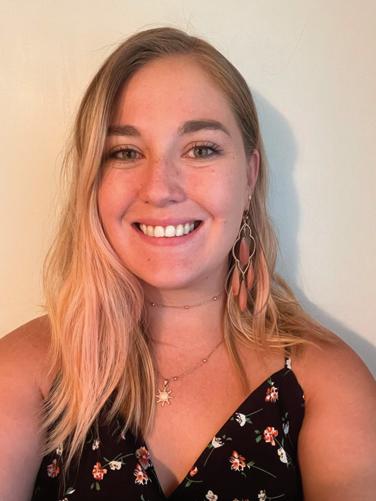
Many words can be used to describe the process undertaken by music educators to program for the school band, but the most important is curriculum. A curriculum is a system of instruction music educators use to teach specific goals, content, and strategies. The desired outcome of the curriculum is the successful transfer of knowledge, skills, and attitudes. Selecting repertoire is one of the most important, challenging, and rewarding roles of an instrumental-music educator but can be a time-consuming and frustrating task. The repertoire we select comprises the largest portion of our band curriculum; therefore, it should be of the highest quality and foster the development of a variety of musical skills. Well-planned repertoire creates a framework for an excellent music curriculum.

Programming requires careful consideration; therefore, selecting repertoire must take place with ample time to outline goals and objectives. The best time to do this is the summer. There are no classes to teach, parents to deal with or other aspects of the job that distract from programming.
While programming over the summer seems daunting and may feel as if it will interfere with work-life balance, it is not
as intensive as one might think; most of what is required for programming is listening. Listening in the car is a great way of getting two things done at the same time. Cutting the grass or doing housework is an opportunity to have music playing and work on programming. With all of today’s technological advances, it is not as difficult or time-consuming as it was in the past.
Early programming provides you with time to select multiple pieces for each category, e.g., instead of programming one march for performance assessment, program two. This gives you breathing room if one does not fit the instrumentation or strengths of the ensemble. Reading and working on multiple pieces (even temporarily) is beneficial, as exposure to more music never hurt anyone. If you are new to a program and need to select music without knowing the ensemble, look at the repertoire previously played. What was played last semester? What did they perform for performance assessment? Were they successful? These are all questions that can help when programming for an unfamiliar ensemble.
Programming early and for the entire year allows you to adjust to the ensemble and time to change as needed. Programming early is not the end-all; it
by Mike Guzmanis the groundwork for a successful and well-planned curriculum.
Not only is programming early important, but programming from the inside out is as well. Since we must plan with the end in mind, it is critical to program in a conscientious order to ensure the growth and experience of our students. Starting with your most important performance leads you to plan for the biggest goals of the school year. Usually, that is music performance assessment. For many, this is one of- if not the most- critical performances of the year. Since it happens in the middle of the school year, programming this first is paramount, as it sets the stage for the spring semester and your curriculum for most of the school year. In programming for this specific performance, it’s important to select your largest most rehearsal-intensive works. This will give you an idea of how much time it will take to put the pieces together, preventing overprogramming and setting you up for success at assessment.
Second, program your spring concert. Typically, this is where you want to stretch the students even more, as it is a short concert cycle due to its proximity to the end of the school year. Less rehearsal time and more challenging
music allow the students to stretch themselves and produce a great product. Programming for the spring comes with a reasonable amount of abandonment: think of works that are slightly outside of the students’ comfort zone. This will prepare and excite them for the next school year.
After programming the spring concert, it is time for the holiday concert. This is a time filled with fun music, but it is important to select music of the highest quality regardless of the genre or festiveness. Luckily, there is a plethora of composers producing high-quality and substantive holiday music. While there are certain traditions and community expectations, it is important to branch out and perform works that are not holiday-related to add variety. There is no “rule” that we must perform solely holiday-oriented music. Remember, the repertoire selected is their musical diet, and a diet consisting of sugar and candy is not healthy.
The final concert to program is the first concert of the school year. Yes, a fall concert! A fall concert sets the stage for more music learning and gives the students a sense of urgency when preparing music. This should be the easiest and shortest program, consisting of quality pieces that are within the students’ ability level. This is an opportunity to reinforce those important marching band fundamentals they have been working on all summer with new pieces. A well-programmed fall concert is a springboard into fulltime concert music.
With repertoire as the basis of our curriculum, it is important to select music of the highest quality. But defining high-quality repertoire can be subjective and difficult. Substantive music that is well crafted, and challenging both technically and expressively must be programmed.
A good starting point is composers. Composers of classic band music such as Grainger, Holst, and Reed are a great resource, as they have contributed to a canon of works of artistic merit. Modern-day composers like Ticheli, Danyew, and Maslanka also have substantial amounts of high-quality, creative, and substantive band music for all ability levels.
An approach for younger bands is programming arrangements of classic band literature by known/excellent composers. There’s a considerable number of arrangements available by talented and reputable arrangers, providing accessible high-quality arrangements of more difficult band classics.
Marches are essential to the band curriculum, as they are an important part of the wind band repertoire, and valuable for teaching many concepts. It is essential to focus on programming marches of high quality, by exceptional composers. As with the concert literature, many outstanding march arrangements are available for bands at any level.
Finally, it is important to program literature by underrepresented composers. There is a wealth of wellcrafted music at any level composed by underrepresented composers that students should be exposed to. As a minority, I believe it is important for students to perform literature composed by people who have similar backgrounds to theirs. This provides not only an educational/musical component but also can inspire minority students to pursue music as a career.
Our goal as educators is to develop students’ abilities and lead them to higher levels of achievement; therefore, selecting appropriate repertoire is paramount. Great care must be taken to program developmentally appropriate music and a considerable amount of research is required to make good decisions. Luckily, there is a myriad of resources available to help educators select level-appropriate literature. Examples are lists from the NBA (National Band Association, n.d.), Teaching Music Through Performance in Band (GIA Publications INC, n.d.), and many state lists. Level-appropriate repertoire is especially important for young educators that may not be well-versed in repertoire selection. These lists vary in how they grade literature and could cause problems with overprogramming; therefore, it’s important to create your own lists with grade levels to help you program. Consulting seasoned colleagues can be more accurate in determining a piece’s actual grade level. Below is a sample repertoire list that includes the piece, composer,
arranger, grade, and JW Pepper number. This is a practical approach, as one can click on the JWP number, and the link will take you to a recording and copy of the score if it’s available.
Having a well-designed repertoire list can help with programming and it is important to keep adding to it. The more pieces on the list, the easier it is to select repertoire, plan, and build the curriculum. Attending university concerts is another, as universities are abreast of the newest repertoire and composers. Attending music performance assessment is also a good resource where one can hear ensembles of comparable ability performing works that may be unfamiliar. Consulting mentors and colleagues is also a resource for finding literature that’s appropriate, challenging, and wellcrafted. Attending conferences is an excellent way of finding new repertoire and perusing scores. Finally, nothing beats doing your own research. This is the most enriching approach to developing an exceptional repertoire list. Being submerged in the actual listening and researching will expand your horizons as a music educator and will benefit the students.
One of the most important factors in programming is the director. A director’s experience as a student, performer, and educator greatly affects the way they program. Therefore, it’s important to conscientiously program to remove yourself as a factor as much as possible.
The first factor to contend with is ego. Many times, the director’s ego get in the way of the music that should be programmed for students. Directors must set aside their egos to better serve the needs of the students. At times ego can take a backseat to sheer ignorance and a lack of knowledge of the
repertoire, leading to programming only the pieces the director played in college or experienced themselves in high school. While these may be great pieces, they may not fit the needs of the students. This should be considered when programming, regardless of how difficult it may be to separate the director’s own personal feelings from the process.
The director’s musical growth is a significant factor in programming. Many times, directors program pieces they know well and understand. There’s nothing wrong with this technique, but it is important to stay abreast of developments in new repertoire. It’s essential to seek out new quality pieces and infuse them into the director’s already established rotation. As a director this keeps you learning as well as provides students with a greater variety of repertoire. Finally, director preparation affects the curriculum and growth of the students. It is imperative that as a conductor/teacher, the director is familiar with and can teach the repertoire before arriving at the first rehearsal. As educators, we expect students to arrive prepared for class and we must do the same. This requires advance preparation and time and can be achieved by intently studying before the first rehearsal. Acquiring scores is simple and can be done online using perusal scores. Borrowing from friends or colleagues is another way to acquire scores and prepare ahead to ensure full preparation before the first rehearsal.
The music we program for our students is the basis of our curriculum. Therefore, the repertoire needs to be of the highest quality, composed by excellent composers, and teach a multitude of musical concepts. The earlier the programming begins, the more focused and detailed the
curriculum is going to be. Take advantage of various resources available for selecting music as well as developing your own. Investigate, study, and seek advice on the best repertoire available. Finally, remove yourself and your preconceived notions from the repertoire selection process. A sound repertoire selection process sets up a solid curriculum for the students. Happy programming!
Works Cited
GIA Publications INC. (n.d.). GIA Publications. Retrieved October 2022, from https://www.giamusic.com/sto re/teaching-music-throughperformance-band National Band Association. (n.d.). Retrieved October 2022, from https://nationalbandassociatio n.org/selective-music-lists/

Mike Guzman is the Director of Bands at Hewitt-Trussville High School in Trussville, AL. Mr. Guzman completed his bachelor’s degree in Music Performance/
Education from The University of Miami. While at Florida International University he received his master’s degree in conducting and served as a graduate assistant for the FIU Golden Panther Marching Band. Currently, Mr. Guzman is a Music Education doctoral student at The University of Alabama. Mr. Guzman lives in Trussville, Alabama with his wife Ada, daughters Abby Grace, Macie Lynn and their dogs.
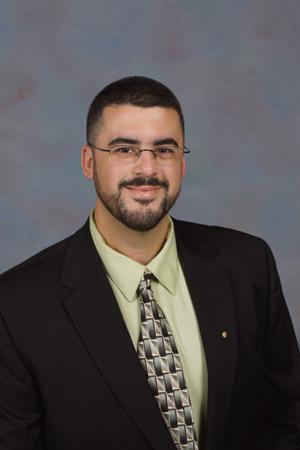

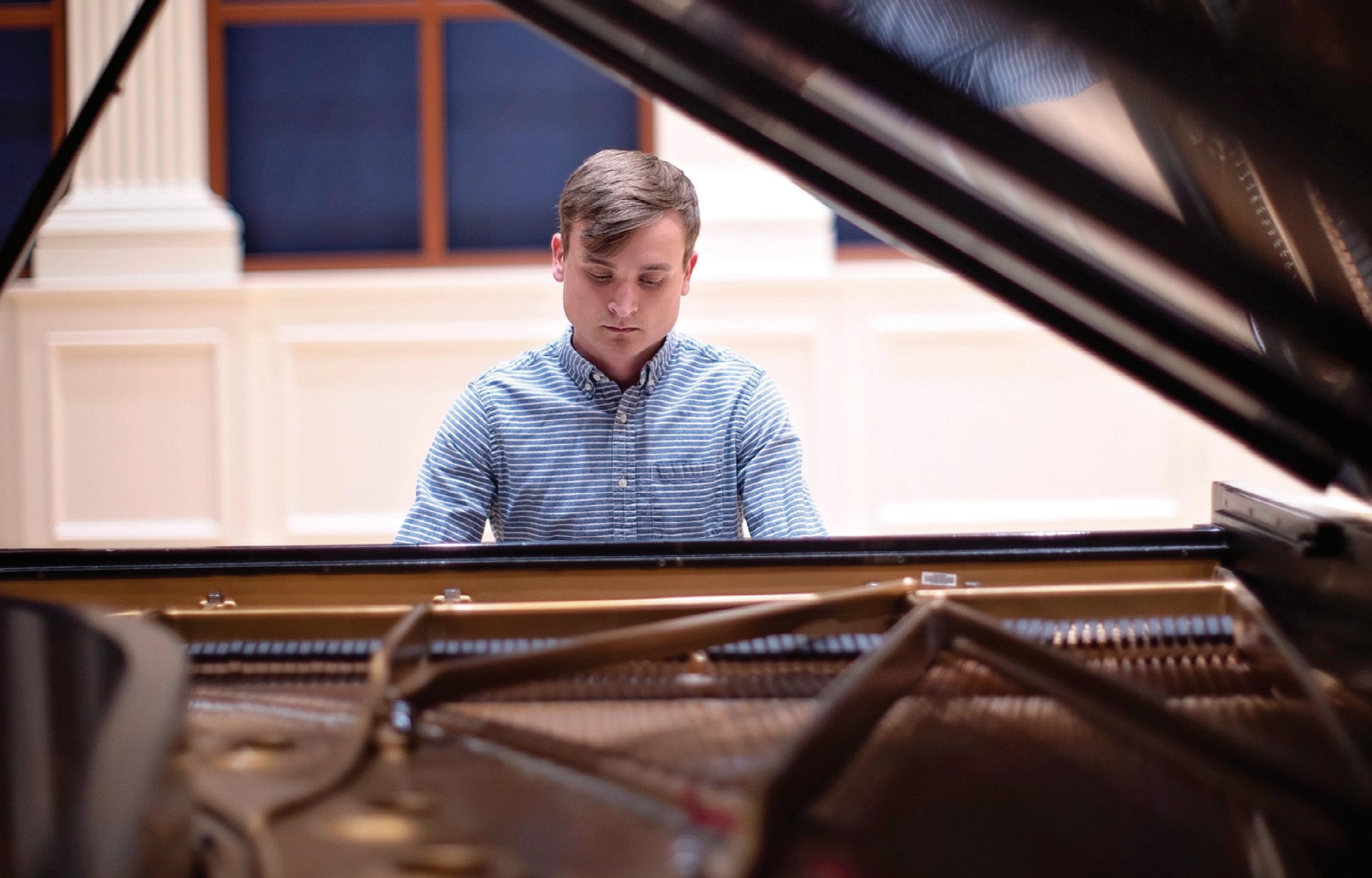



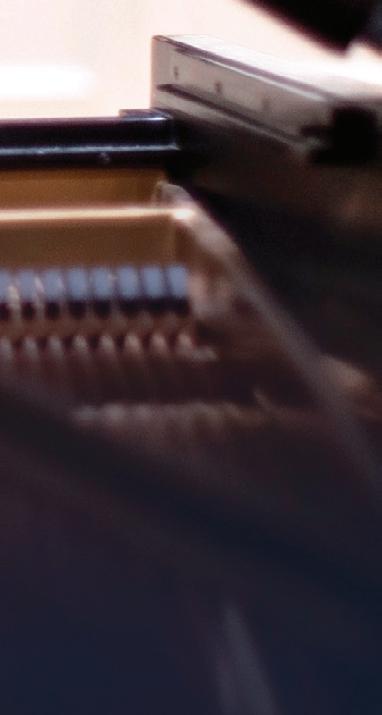



What do students get to do? What musical experiences does your program offer students? Consider activities available based on musical skills students will exercise. These skills include, but are not limited to performing, listening, responding, and creating.
First, in what ways are students able to perform music in your program? These activities seek to develop individual and ensemble performance skills.
Orchestra • Choir • Show choir
What now? When a student graduates from the music program, how do they continue to interact with music as an adult?
Did the experiences they gained through the music program prepare them with knowledge and skills to interact with music beyond playing the clarinet in a wind band?
by Patrick Greeneof providing input through the committee structure. In this model, committees are student-run, but will require oversight from the music teacher to guide and develop student leadership, brainstorm ideas, teach key concepts through group and one-on-one instruction, etc. The goal should be to get these committees started at an intersection between the vision of the music teacher and the interests of the students.
•
• Concert Band
Marching band
• Indoor percussion/winds/color
• guard
In asking these questions, an educator might discover that the primary skill of music most programs tend to emphasize is performing. This is logical because music requires musicians to perform it, and performing music offers musicians a way of experiencing the art. However, is performing the only way of meaningfully interacting with music? How can we reimagine the music program to reflect the variety of skills and musical interactions we want students to have?
•
Jazz band
• Solo and ensemble
Next, in what ways are students creating music? Are students afforded opportunities to study music’s inner workings and create their own art?
Music theory • Composition and songwriting
•
• Music technology and production
Does your school offer its students opportunities to listen and respond to music critically? Students develop these skills most commonly in music appreciation and general music.
Despite the numerous activities already listed above, most students must choose one activity over another to participate in music programs. Most commonly, students learn to play one instrument in one or two types of ensembles, each with its own procedural applications and bodies of literature. For instance, a high school clarinet player would participate most likely in the concert and/or marching band as their primary means of interacting with music. This student will spend their high school career primarily playing school band music which requires procedural knowledge and skills related to the performance practice of the clarinet in the wind band setting.
What if? Imagine for a moment that you, the band/orchestra/choir director, are no longer just the director of a band/orchestra/choir program. For this moment, you are now a music teacher in charge of a music program at your middle school or high school. Students are no longer just a part of the band, orchestra, or choir, but now are a part of the music club. This music club (choose a school-themed name) offers committees to its members which represent the interests of students, guided by the vision of the music teacher. Members of the committee are given tasks and jobs as voted on by the committee, meaning each student will be given individual responsibility. A committee format encourages student leadership and collaborative brainstorming around shared interests, and models what community and business committees might look like in the world beyond school. Think now, how can this program offer experiences which reflect the variety of skills and musical interactions we want students to have?
Music Committees. A key facet of this music program model is the encouragement of individual student engagement. Through involvement in committees, students can be empowered to create projects, plan performances, create social media platforms, and collaborate with their peers and community. Here, all students’ voices are given a means
When students join the music program, they will be invited to try the myriad of instruments available, including wind, percussion, strings, guitar, and piano. All students will be assigned to a voice part, as singing will be an integral part of being a part of the music program through group songs, school anthems, and as a general means of interacting with music. Students will then select a primary instrument of study, as well as a recommended secondary instrument they are interested in pursuing (guitar and piano are highly encouraged as secondary). Students will then select 2-3 committees to join based on interest. Consider how committees are balanced with involvement, smaller programs, and larger programs will have different considerations to make on how many committees to offer and how students will distribute themselves.
Music Publication Journal. Another key element of the music program could be a student-led publication distributed to the school and community. This is a great opportunity for students to develop critical listening and writing skills in discussing music. All committees in the program are encouraged to contribute. Students on this committee will be responsible for curating the bi-weekly or monthly journal with topics related to but not limited to:
• Analysis of popular and art music
Popular music, what’s trending
• Concerts and local music events
• Artists, genres of music
• Teaching non-music peers about
• music using relatable language
Talk about what the committees in
• the music program are working on Advertise and sell music program
• merchandise for fundraising
Below are ideas for committees you could offer for student participation. Consider offering your favorite 6-8 options based on the resources available.
Music Publication Journal
• Orchestra – historical music prac-
• tice
• literature, gospel
Choir – SATB, secular and sacred
• Show choir and musical theater
A Capella - barbershop, doowop
• Wind band - concert prep, honor
• band/clinics, conducting opportunities
• show design concepts
Marching and pep band – Drill and
•
Jazz Ensemble
music program and yielding back musical experiences and opportunities to the school and greater community. You can discuss how these opportunities will connect with all students and enrich their education with more culturally responsive and relevant musical experiences. Emphasize that these opportunities are student-driven, culturally relevant, and will encourage increased participation in the music program. Individual students are given voices and responsibility through a committee structure that models the workings of professional and organizational committees.
of the school’s public image, such as a new music ensemble or school publication? Could a bigger student-driven social media presence around music be a fundraising opportunity?
Popular music ensemble- 4-6 per-
• son bands, learn technique + songs, plan performances
Music production and technology-

• sound design, mixing, editing, producing, tracking, recording, composing
• struction and smaller ensembles
Guitar and ukulele class- group in-
• one instruction
Piano class – group and one-on-
•
Music theory and composition- AP
Theory, composition and counterpoint, analysis, tutoring
Percussion ensemble
•
• music of other cultures
World Music ensemble – Explore
• color guard
Visual Ensemble – Dance, twirling,
General music – open to all stu-
• dents in the school who take the class. Concert opportunities, involvement in music program events (recruitment opportunity), group instruction of music concepts, and introduction to instruments.
Now, to find a way to present potential ideas to the administration. Think of these committees as a potential class or after-school opportunity to present to your administration, keeping in mind how you can maintain a balanced teaching load with respect to your other responsibilities. The committees are a representation of the shared vision of the teacher and student seeking to provide meaningful musical interactions for students and the community. With this model, a music teacher could expect to interact with a greater percentage of the student population over time, improving participation in the
Create a document detailing the 1 musical opportunities you will offer students. Allow the student body to read about the various musical opportunities available and vote on their favorites. If possible, offer demonstrations of the different activities. If students select 3-5 favorites, a director can determine the general interest amongst the student body at large through a distribution of the votes. Select the top 3 favorite opportuni- 2 ties. Consider the flexibility of your own schedule and determine where, if at all, any of these could be placed. Many teachers do not have the luxury of determining their teaching load or schedule. If this is the case, could 1-2 of these musical opportunities become an extension of the music program as an after-school or before-school activity? Would any of these opportunities be justifiable as a school club classification? Consider what a year at a glance would look like for these opportunities. Discuss with your administration 3 the favorite potential opportunities students could take part in. How will these opportunities encourage student engagement? What is the role of the director in overseeing committees? How will these activities enrich the education and lives of students? Be prepared to discuss the 4 cost/benefit analysis of these suggestions. Some of these opportunities can be more affordable than the average band/orchestra class. Is there a way any of these new opportunities could be a visible part
Finally, it is important to remember that change happens slowly. While the premise of this article is not a new one, it can be considered drastic to try to shift an entire music program’s structure overnight. Instead, a teacher could gauge student interest in current opportunities and potential ones through yearly or bi-yearly student feedback to gather information on satisfaction and engagement with their music education. Consider a musical opportunity each year to offer students through either a class or club activity that appeals to the unique lives they lead as young adults in the present day. Students deserve teachers, especially music teachers, who are willing to consider their tastes and individual experiences as beautiful and valid as a “sophisticated adult”. Sticking to the way you have done things before can be comfortable and reassuring as a teacher when you rely on consistency as a means of getting through the year. Yet, while you may get to teach these classes again and continue running your program, your students will only have what you provide them within the short time they are with you. Did you take the opportunity to show your students all music has to offer? As the music teacher in their lives, did you provide your students opportunities to interact with music in the numerous ways we see music manifest in life?
Patrick Greene graduated from Troy University in 2019 with a Bachelor degree in Music Education. After receiving his degree, Mr. Greene taught music theory, aural skills, composition, and horn lessons at Ars Nova School of the Arts in Huntsville, Alabama. He is currently pursuing a Master’s degree in Secondary Music Education at the University of Alabama.


It is the first day of playing instruments in a beginner band. After weeks of rigorous instruction in the fundamentals of music reading, developing a steady beat, and generating consistent tone on the mouthpiece, the students are eagerly awaiting instruction from their teacher to begin assembling their instruments. The trumpets place their mouthpieces on their lead pipes and play their first note –a resounding open C or G. The teacher calibrates the students’ embouchures by having them manipulate hot and cold air, high and low tongue arch, and “ee” and “oo” syllables to switch between the two notes. They successfully repeat this process for each brass instrument, generating their first concert Bb or F. Now it is the horns’ turn. They set their embouchures, prepare for success, and…honk! A cacophony of notes fills the room. Henry plays an open C, Akari an E, Saddiq a Bb, and Jordan, Dae-Jung, and Sasha seemingly play every note of the harmonic series. Despite their best efforts, the teacher fails to get each student on the same note, leaving the young hornists frustrated and disappointed that they were not as successful as their friends.
Band directors have long grappled with starting horn students in a manner equitable with students on other instruments. To combat the mercurial nature of the instrument, many seem to opt for stopgaps in their pedagogy. Some choose to start students on trumpet and switch them to horn after “developing a sense of pitch.” Unfortunately, the trumpet and horn embouchures are so distinct that switching students from trumpet to horn can have long-lasting detrimental effects on embouchure and tone without proper guidance. Others incorporate rigorous aptitude testing in their recruitment process to ensure only students with inherent music skills (e.g., pitch recognition) are placed on horn; however, this practice limits student choice. Numerous beginning band method books offer exercises putting students in harmony with the rest of the band (usually a fifth), but directors should ensure that their hornists are given sufficient time
playing in unison with the ensemble to develop intonation, tone, and blend. These methods operate on the premise that the horn is an inherently troublesome instrument that is difficult to learn and even more challenging to master.
In reality, the horn is no more challenging than any other brass instrument. The problem is that we have been hindering our young horn students with the most challenging version of the horn for decades – the horn in F – even though a more beginner-friendly instrument is readily available – the horn in Bb. The purpose of this article is to address common misconceptions that have led band directors to inefficient workarounds with their beginner horns and make a case for starting on the Bb horn.
The Trumpet is Not a Solution…It’s a Trumpet
Directors who start their horn students on trumpet often cite the small size of the horn mouthpiece and the difficulty of the horn’s harmonic series. However, the design of the two mouthpieces are unfortunately too distinct to function as analogs of each other. The trumpet mouthpiece has a thicker rim with a shallow cup that quickly tapers towards the shank. The horn mouthpiece has a thin rim with a deep cup that gradually tapers towards the shank. Furthermore, the trumpet mouthpiece sits approximately in the middle of the embouchure, pointing forward, with 50% top lip and 50% bottom lip. In contrast, the horn uses 2/3 top lip and 1/3 bottom lip, but also requires setting the embouchure correctly. To properly set the horn mouthpiece, have the student hold it perpendicular to the ground with the rim resting just underneath the pink of their bottom lip. Then, tilt the mouthpiece until it touches the top lip, resulting in a downward angle and a 2/3 top lip and 1/3 bottom lip ratio.
An overly tense embouchure is a common concern for brass players, but especially for hornists. If students are struggling to “fit”
by Russell Greenetheir horn embouchure into the mouthpiece or cannot generate a clear buzz, they are likely working too hard. To overcome embouchure tension, have students hold a balloon and fill it with air. Then, have them do the same task without holding the balloon. Without the security of their hands, the students will puff their cheeks and struggle to push air through the balloon or they will naturally firm their corners and direct the air forward. Guide the students until the second outcome occurs. Then, have students blow air without the balloon, keeping the same embouchure shape with firm corners. Making an OK sign with their right hand, have the students blow air and slowly move their hand towards their embouchure. As the circle of the OK presses into the embouchure, a buzz will naturally occur. Repeat this process with the mouthpiece. Then, have students blow air through the mouthpiece as they connect it to the horn, and a buzz will occur once connected.
Developing a relaxed embouchure from day 1 is key to effective brass playing. An efficient buzz is not a strength activity, but an air activity. Surprisingly, very little tension is needed to produce a pitch on the horn. The backpressure caused by the lead pipe will create a natural buzz through the Bernoulli Principle; therefore, hornists should focus on firm corners, quality airflow, and let the horn do the work for them!
Look no further than the harmonic series to understand why the F horn is a challenging instrument for novices and professionals alike. Shown below is the open-valved harmonic series of the F horn. The horn is one of the few instruments that can generate the entire harmonic series with its fundamental. The typical beginner trombone/euphonium tessitura operates between harmonics 2 through 4 (tuba an octave lower). The trumpet’s harmonic series is an octave
higher and cannot generate the fundamental pitch; therefore, the second harmonic starts on C4. With an interval of a fifth between their second and third harmonics, trumpets, trombones, euphoniums, and tubas have a wide margin of error when targeting a specific harmonic. A beginner horn’s tessitura, on the other hand, generally sits between harmonics 4 and 8 – C4 and C5. This means the open-valve series can generate C, E, G, Bb, and C – a narrow margin of error for beginning students.
strument manufacturers continue to market the F horn?
The Bb horn is smaller than the F horn; therefore, its harmonic series (shown above) is raised a perfect fourth. The beginner tessitura is much more manageable with harmonics 3 through 6 and a perfect fourth separating C4 and F4. This margin of error does not match the perfect fifth of the other brass instruments but significantly lowers the difficulty compared to the major and minor thirds of the F horn. By incorporating the other valve series, the C scale (Concert F) becomes more accurate on the Bb horn (shown below).




The truth is that skilled hornists need to use both sides of the horn. The F horn is a beautiful instrument with a rich tone and solid intonation in the instrument’s low range but struggles with accuracy and intonation in the middle and upper range. The Bb horn offers richer tone and accuracy in the middle and upper range but lacks the F horn’s low range depth of tone. As hornists mature, they learn to navigate 14 horns (F side valve combinations: 0, 2, 1, 12, 23, 13, 123; Bb side: 0, 2, 1, 12, 23, 13, 123) and discern how to take advantage of the fingerings that provide the best intonation, action, and accuracy across the harmonic series. Training in the early weeks on the horn should involve the mistakelimiting benefits of scalar exercises and etudes on the Bb horn while utilizing the F horn for accuracy training via arpeggiated lip slurs.
As an additional disclaimer, Bb horns do not share trumpet fingerings despite being pitched in the same key. Bb horns still read in F, which is written a fifth above its sounding concert pitch; therefore, Bb horn fingerings are the same as euphonium. For example, C4, D4, E4, F4, and G4 on the horn are concert pitches F3, G3, A3, Bb3, and C4, respectively. The Bb horn and euphonium fingerings for these notes are identical (shown below). Therefore, directors should avoid giving their students trumpet fingering charts for the Bb horn or distributing trumpet or treble clef euphonium parts.
single Bb horns include Alexander 88 and Yamaha YHR-32II. Some advanced models, such as Alexander 90 and Paxman 10, include a stopping valve that adds a ½ step of F horn tubing. The stopping valve offers more accuracy for stopped technique on the Bb horn by pulling the additional tubing as far as needed for more control over the pitch.
Regardless, band directors should feel comfortable starting beginners on Double F/Bb horns and focusing on the Bb side (thumb-trigger) in the early weeks. This allows the director to push students towards utilizing both sides of the horn whenever they have reliable accuracy, air support, and tone quality. Double horns can cost $1000$3000 more than a single horn and are much heavier, so directors should always consider their budget and the size and strength of their young students.
I should add that starting on the F horn instead of the Bb or double horn is not a “death sentence” for beginners. Many successful hornists started on the F horn and continue to this day. But misconceptions surrounding the difficulties of the F horn have led directors to workarounds they would not otherwise use for other instruments. Consider how many more hornists there would be if their beginner experiences were not frustrated by improper embouchure technique, note inaccuracy, or switching from other instruments. Starting on Bb horn puts students on equal footing, allowing more students to achieve the same early successes as their brass peers, enjoy their instrument, and stay in their band programs longer. The world needs more horn players and using the Bb horn is one way to make it a better place!
Playing on the Bb horn is like using bumper lanes at the bowling alley, helping novices avoid the gutter, and guaranteeing pins will fall. Better yet, it puts young hornists on roughly equal footing as their brass peers, meaning concerns about starting on trumpet, getting students with “good ears,” and using exercises in harmony become much less relevant. Students are most likely to continue in their band when they make good sounds, frequently achieve proximal goals, and feel like they are on par with their peers. With all the clear benefits of the Bb horn, why do in-

Band directors should consider these options when purchasing or recommending horns for their students. The long-running practice in many programs is to start beginners on the single F horn, which comes with the pitfalls previously mentioned. In contrast, the single Bb horn is lighter and often slightly cheaper than the single F horn, ideal for small children. Some quality
Russell Greene is a Ph.D. candidate in Music Education at the University of Alabama where he composes and teaches music education methods and private horn. He is a former middle school and high school band director and his groups have consistently received superior ratings.
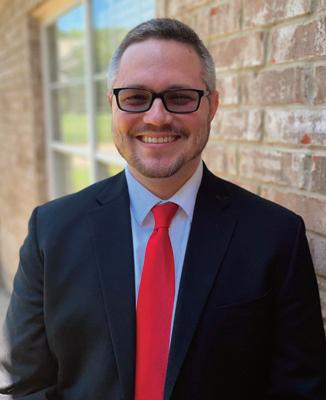
Ihope everyone had a good midyear break and a strong start to the semester. Like many of you, I was excited to be able to attend the Midwest Clinic in December. I hope those of you who attended were as blown away as I was hearing the performances in person. The composers and ensembles throughout the clinic were incredible, and there were a few pieces that stayed on replay in my head after I was back home.
Safely Rest (2020) was included in the William Mason High School Wind Symphony concert. It is a grade 3 piece by Nicole Piunno (www.nicolepiunno.com). Dr. Piunno holds a Doctor of Musical Arts degree in Composition and a Master of Music degree in Theory Pedagogy from Michigan State University, a Master of Music degree in Composition at Central Michigan University, and a Bachelor of Music degree in Music Education from Ohio Wesleyan University. She has studied composition with both Ricardo Lorenz and David Gillingham.
Safely Rest expertly combines the melodies of Amazing Grace and Taps. This medium difficulty setting features the two melodies woven together so they can be perceived as a single unit. Piunno indicates that the following parts have non-essential divisi: Flute 2, Oboe, Bassoon, Clarinet 1, Trumpet 1, and Euphonium. She also indicates in the score which notes can be left out. The percussion parts can utilize five to six players, with the Chime part being omitted if needed. This five-minute work contains a key change from Bb Major to Eb Major and back to Bb Major, with minimal use of accidentals. This piece is beautifully crafted, smartly scored, and emotionally impactful. Safely Rest would be a moving addition to a concert program.
A recording and score of Safely Rest can be found at https://www.nicolepiunno.com/safely-rest
Stillwater (2019) was also included in the William Mason Wind Symphony program. It is a grade 4 work by Kelijah Dunton (https://kelijah.com). Dunton, a New York-based composer, is an emerging voice in the wind band world. Stillwater was originally written for the Shoreview Northern Lights Variety Band, a community band in Minnesota. Dunton states that this work is inspired by the beauty of the small town, Stillwater, MN. From Dunton’s notes, “This town has a big lake in its center, and out of everyone’s backyard, it could be seen. During the winter, the very top of the lake freezes and creates this tranquil effect that could not be seen, but heard. When stepping out into your backyard, you’d see this frozen mass, stuck into place and completely unmovable, but if you listened closely, you could hear that the water underneath continued to flow. Why is this important? We as people forget sometimes that we are so much deeper and more vast beneath our hard surfaces. We work, we go to school, we take care of our families, and we deal with the struggles of the day-to-day routine militantly. But if we just take a moment to listen within ourselves; we discover our passions, our longings, and our sense of belonging.”
This four-minute work, while only clocking in at 56 measures long, contains many opportunities to challenge ensembles. Thinly scored moments require confident playing throughout the ensemble. Frequent accidentals as well as an oboe solo add to the difficulty of this
by Dr. Jeremy Stovallwork. While only five percussionists are needed, the parts are very independent and require strong players on every part. This piece is introspective with a reflective, peaceful ending. Stillwater would be a great addition to a program and will highlight the musical maturity of your ensemble.
A recording and score of Stillwater can be found at https://kelijah.com/products/stillwater-2019-for-wind-ensemble
Another great performance was the O’Fallon Township High Wind Ensemble’s world premiere of AYO (2022). It is a grade 4 piece by Katahj Copley (www.katahjcopleymusic.com). Katahj received two Bachelor of Music degrees from the University of West Georgia in Music Education and Composition in 2021 and is currently studying composition with Omar Thomas at the University of Texas at Austin.
From the composer: “Rooted from hip hop and jazz culture, AYO is built in the black language. It’s used to tell when something is right, when something is wrong, when something is awesome, and when something is too sweet for words. Its use is seen with your closest people, your family, or people who know you best. It’s personal. In short “AYO” is a personal embrace that can represent life. With this piece I wanted to build the kind of embrace you would get from this word alone while also honoring its beginnings-using hip hop rhythms and colorful harmonies. By the end of the piece, we the listeners go from uncertainty to home; and with the uniqueness of the piece, we in turn celebrate not only a word like AYO but also celebrate life.”
Throughout the work, the tempo is consistent except for the ending, which slows to a climactic finish. Rhythmic layering adds to the sense of excitement in this piece. A constant underlying rhythmic motor element is present at all times creating a steady pulse to keep the ensemble grounded. The opening section features driving melodies that contain some use of syncopation, while the middle section contains lyrical melodies over a rhythmic ostinato. Muted doppler effects in the brass and colorful harmonies add to the intrigue of this piece. The highly involved percussion writing, utilizing 20 instruments, will need at least eight players. AYO would be a high-energy addition to a program as an opening or closing piece.
A recording and score of AYO can be found at https://www.katahjcopleymusic.com/ayo
Each of these pieces has exciting elements that will bring energy and emotion to a program. I hope you all enjoy listening to and studying these pieces as much as I have. Best of luck to you and your students through your spring concerts and MPA performances. Please reach out if I can ever be of assistance!
Dr. Jeremy Stovall Assistant Director of Bands Associate Professor Jacksonville State University jstovall@jsu.edu
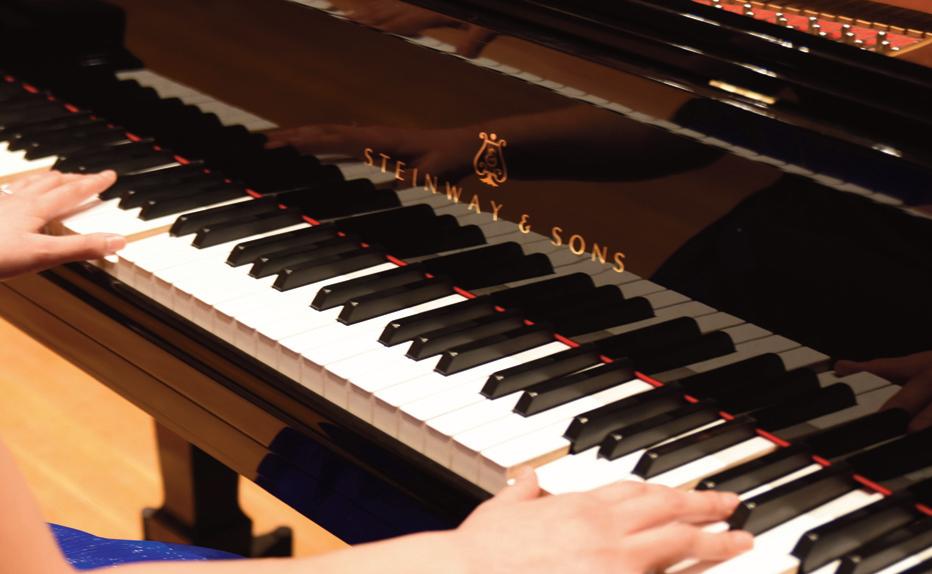

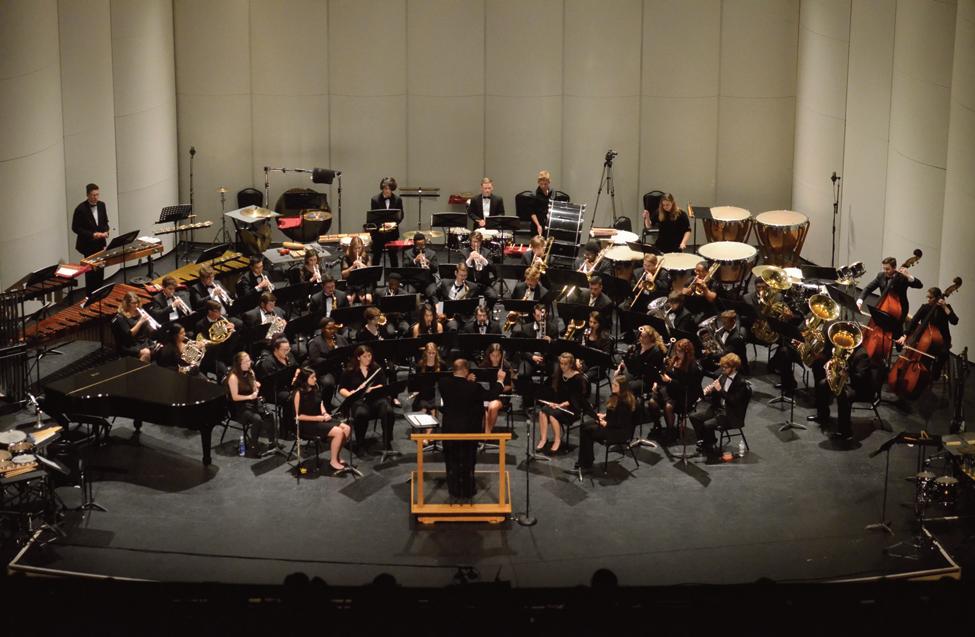






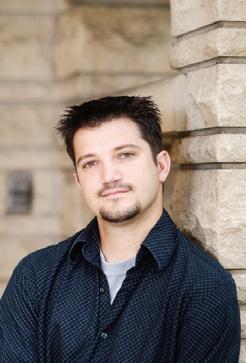




Jam sessions are an important part of learning how to play, interact, and musically converse with your fellow jazz musicians. There are often various levels of jams, from those specifically arranged for young players to hone their craft, all the way to professionallevel cutting sessions that carry high expectations and unspoken rules. Playing at a jam session is a vital learning experience, and Dr. Dave Camwell, Professor Chris Kozak, Dr. Stephen Roberts, and Dr. Andy Nevala list valuable tools for you to be successful!
Professor Dr. Dave Camwell Troy University, Director of Jazz StudiesI recently had the honor of hosting a jam session for the 2023 AMEA honor band jazz musicians, and here are some suggestions for high school age jazzers who are going to participate in this valuable jazz performance practice:
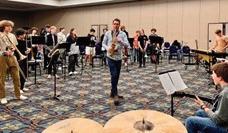
COME PREPARED! Memorize at least three tunes 1 that you feel comfortable playing, including counting off, intro and outro, form, style, melody, and chord changes. More than three is even better, in case somebody else calls your tune before it’s your turn!
MELODY: Do not play the melody as exactly 2 written on lead sheets/fake books. The melodies for many standards are commonly written in a very basic rhythmic way. Nothing says “newbie” quite like playing 9 straight quarter notes in a row…listen to professional recordings to know how a tune is really supposed to sound!
MELODY part 2: If there are multiple horn players 3 (usually 3-5 are common) on a tune, DO NOT all play the melody in unison! A much better idea is to trade off the phrases (typically 8 bars), or possibly harmonize or create a secondary backing line underneath the melody.
AMOUNT OF CHORUSES: Do not play more 4 that 2-3 choruses on any tune. Every note you play
should be compelling; imagine you were being charged $.25 per note - make each one count! Don’t fill up needless space unless your harmonic and rhythmic material is so strong that you truly have enough content to artistically fill the space that is allotted. The golden rule is to leave people wanting more! …by the way, Charlie Parker rarely played more than three choruses, and as he said, “anything more than that, you’re just practicing…”
BODY LANGUAGE: Jazz is a fluid artform, and 5 often things change quickly on the bandstand. One person (often a horn player) should take charge in making sure that the major elements of the tune (intro, division of melody, solo order, trading with drums, outro, tag, ending, etc.) are communicated to all members.
TRADING 4’s WITH THE DRUMMER: 6 Remember the solo order! The order that musicians solo becomes the order that you alternate in trading 4s or 8s with the drummer. Make sure you are aware of where you are in this formula, and that you don’t get lost in the form!
ATTITUDE: In addition to your playing, how you 7 treat your fellow musicians will largely define you as a musician and a person. Jam sessions are
commonly held to support and promote jazz for up-and-coming musicians in the community. Be respectful of your elders, and be supportive and encouraging of your fellow players. Do not use this as an opportunity to play faster, louder and higher than everyone around you. Leave your ego at home, and present your very best musical and personal self on this stage.
HUMILITY: We are all just a small cog in the giant 8 wheel of music. There is always someone better than you at your instrument; approach every musical performance such as jam sessions as an opportunity to share your love and hard-earned musical skills with others. Just make sure that you are cognizant and respectful of the history and traditions of this music, and that you engage with your fellow musicians with humility, preparation, a positive attitude, and a willingness to accept that things may not always go quite the way you envision. Jazz is much like life - you often have to improvise and think quickly in ways that are unexpected! That’s all part of the fun - now go make some beautiful music and carry this music forward with YOUR musical voice!
In my experience, the rules for participating in Jam Sessions aren’t always universal. There may be specific guidelines regarding how and where to sign-up for a spot, tune selection or restrictions, number of choruses you are allowed to play, and how many soloists can be on stage at one time to cite a few. It only makes sense to check for that information with whomever is running the session or on the signup sheet. PRO TIP: Pay attention to which tunes people are signing up for and add them to your repertoire so you can play with those individuals next time!
After you’ve signed up and selected your tune, have your instrument out and ready to play when it is your time i.e., put together, tuned, etc. You should be able to play the head of the tune you selected, know the key you’re playing it in, the tempo you’d like, and the feel/style. You might suggest an introduction if the rhythm section doesn’t already have one but if not, they’ll generally pick it for you. If there’s no intro, they’ll usually just expect you to go directly into the melody or as we say, “right on it.”
Here’s where things can vary. Whoever plays the head gets the first solo unless more than one player joins in. If there
is more than one soloist, you’ll need to make the call on the fly and be willing to either step up or let someone else take the first solo. Remember, be fair and limit your solo length. This can be a challenge but try to hold yourself to one or two choruses depending on the tempo. Remember, other folks want to play too! The rhythm section may want to solo so don’t be afraid to ask (but not on every tune.) Trading 4’s or a solo for the drummer is a great way to break up the monotony too. When you aren’t soloing, engage by listening to everyone else’s solo but step aside so they can be the focus. A lot can be learned here!
When the tune is wrapping up, if you haven’t already discussed an ending, communicate musically or otherwise how you’d like to end. PRO TIP: Learn as many introductions and endings as you can and be able to draw from them at will. Unfortunately, how to end the tunes is often forgotten about and seldom discussed in the heat of the moment. Be ready to pull some of those out in a split second. Transcribing several intros/endings from recordings of Jazz Standards and memorizing them in all keys is extremely beneficial for all Jazz players. Don’t always leave it up to the Rhythm section or you may get the “Ellington ending” on every tune!
When it comes to selecting repertoire, medium swing and Latin tunes are great. Up tempo burners are usually fine but be prepared to take a few extra choruses. A ballad is acceptable but only take one chorus or even half depending on who else is playing. It’s great when someone calls something out of the ordinary, but it makes sense to pick tunes that are in the standard rotation of that particular group at the session. The idea is to get as many folks up playing as possible and picking something lesser known might hinder that. A few common tunes called are: “There Will Never Be Another You,” “Solar,” “Alone Together,” “All the Things You Are,” and “Take the A Train.” It’s not limited to just those so, again the sign-up sheet will be helpful in picking a tune you’d like to play on!
Those are just a few points I wanted to draw attention to about Jam Sessions. They can be great places to hear your peers, learn new tunes, play some of the material you are practicing, and develop a network with like-minded musicians. It’s also great to play with live musicians and interact through music instead of just a play along or iRealb. Find the closest one to you and go often!
ProfessorDr. Steve Roberts The University of Alabama at Birmingham, Director of Jazz Studies
Jam sessions are a great way to improve your jazz playing, meet some like-minded musicians, and have a lot of fun. The beauty of jazz jam sessions is that anywhere you go in the world there are a set of tunes that pretty much everyone will know. I have attended jam sessions in Colombia, Japan, France, Germany, the Netherlands, and all around the US, and the tune choices did not vary much. There are some great sites online like learnjazzstandards.com that keep lists of these core standards, but you can also just go to the sessions and take notes. I tell my younger students that while it’s ok if they just want to watch the first couple jam sessions and get an understanding of the process and what tunes people are likely to call.
As a horn player it is important to have some tune melodies memorized. If you don’t know a tune, just sit out and wait for the next one and make a note to learn the tune you weren’t familiar with. Real books and sheet music are generally discouraged at jam sessions, although since iReal Pro came out many rhythm sections keep their eyes glued to their phones for entire tunes. Horn players often frantically study the chords on their phones before it is their turn to solo, but rarely look at it when they play. While this has become standard fare, I encourage my students to do their study and chord memorization in the practice room before the session.
As my colleagues outlined, don’t take too long of a solo. Be polite to the other horn players by not taking up too much time, and understand that the rhythm section often does not want to play 50+ choruses of a tune. If you don’t know how long is too long, then ask one of the more experienced musicians and they will give you a ballpark estimate. Most of the time you will sound better if you limit yourself to a few choruses anyway.
Most importantly, these sessions are about interaction! There are plenty of opportunities to practice with playalongs and your metronome. Use these sessions to explore the conversation between the soloist and rhythm section. If you are a soloist, leave room for a response from the rhythm section. Often you’ll hear a solo that is a non-stop string of notes with hardly even room to breathe. This doesn’t allow for the conversation. It’s like asking someone “how was your day” and their answer is a two-hour lecture. That’s not a conversation. Often if solos are too busy and long, the rhythm section will just check out and stop trying to interact and nobody benefits from that. The beginning of your solos is a great spot to allow for space and to not be in a hurry. By starting this way you allow the rhythm
section to be a part of your solo and everyone as a team develops the music organically. Rhythm section players, understand that you are not an accompaniment machine, but part of the music. Even if solos and tunes get long, try your best to listen to and interact with each soloist. This counterplay is the true heart of jazz and it’s one of the wonderful, unique things about this art form.
Jacksonville State University, Director of Jazz Studies
My colleagues have listed many great tips for having a successful jam session experience. We all started out playing in jam sessions before we started playing jazz gigs; the process of hearing songs played by the older players, going home and learning them, and then coming back the next week to sit-in was invaluable to our development as jazz musicians.
When I first became interested in jazz, I would attend jam sessions just to hear the experienced musicians play. I would sit in the corner, write down the song names, and just watch and listen. It took me a few months to get up there and play “Blue Bossa” for the first time, and then I was hooked. Remember, a jam session is an audition for you to show what you know to the other musicians in the room, and the musicians I met and played with at those sessions led to my first real paying “gigs”.Take it seriously and learn the correct melodies and chord changes, because the Real Books are full of mistakes. You will only learn the correct chord changes and melodies by listening to the ORIGINAL recordings of the songs.
For rhythm section players, the original recordings are also where you will find the correct piano/guitar voicings, comping rhythms, grooves, introductions, and endings, most of which are not in the Real Books. The IRealPro App is good for practicing by yourself and great to have when you experience a jazz emergency when an obscure tune is called, but there is no melodic information, and you can’t really comp appropriately without any melodic sense.
Memorize as many standards as you can! I’ve found that the human brain can only handle a limited amount of information and stimulus coming your way at any given time. If you are reading out of the Real Book and don’t know the song you are playing, it takes up brain capacity (much like a computer) that should be used for interacting with the soloist, rhythm section, or soloing. You should be able to close your eyes, open your ears, and try to really live in the moment - that’s when it’s the most fun!
AMEA would like to express appreciation to the following partners who have joined AMEA in our efforts to promote music education in Alabama. Please support these industry/institutional members who support you as music educators!
American Travel Consulting
P.O. Box 750, Albertville, AL 35950
Arts Music Shop, Inc.
3030 East Blvd, Montgomery, AL 36116
Gadsden Music Company
607 Broad Street, Gadsden, AL 35901
J.W. Pepper
191 Sheree Blvd, Exton, Pennsylvania 19341
Marchmaster
P.O. Box 73370, Newnan, GA 30271
Performance Carts
11212 AL Hwy 157, Moulton, AL 35650
Southern Performances
PO Box 6852, Gulf Shores, AL 36542
Troy University
John M. Long School of Music, Troy, AL 36082
University of Alabama Department of Music Education Box 870231, Tuscaloosa, AL 35487-0231
University of North Alabama
UNA Box 5040, Florence, AL 35632
University of South Alabama
5751 USA Drive South, Mobile, AL 36688


